






Teys
manager
gelding sired by Brown Victory and out of Duncans Emmi.






By Fiona Gowers
Queensland’s stud-stock sector is riding a wave of momentum through spring with impressive results in both bull and sheep sale rings.
Across Queensland, seasoned buyers and commercial breeders are attending sales in force, seeking high-quality genetics to prepare for the next season.



Bull sale clearance rates north and south of the border continue to tick above historical averages.
On the sheep side, tight supply and sustained export interest are helping stud ram markets maintain stability.
With spring being a strategic timing window for herd upgrades and breeding decisions, the season’s sales are delivering both confidence and tangible outcomes.
Overall, Queensland breeders report strong buyer engagement, solid averages and an active marketplace.
The message is clear — good genetics remain in demand and the sale ring is a vital avenue for capturing that value.
COVERAGE PAGES 4-5
The Southern Hemisphere’s largest Brahman sale, Rockhampton Brahman Week (RBWS), was a bidding smash, retaining a total clearance of 96 per cent.
Held from Monday, 6 October to Wednesday, 8 October, the event saw over 750 red and grey Brahman bulls, including 576 polled and scurred, go under the hammer. A total of 712 bulls were sold out of 759, with a sale average of $11,540 and a gross of $8,216,500.
The sale kicked off strongly on day one with the highest-priced grey, Token Playboy1286/3, lot 150, selling for $120,000.
STORY PAGE 12



Address: 154-156 Haly Street
Kingaroy 4610
Telephone: 07 4182 0450
Website: QueenslandFarmerToday.com.au
CONTACT US
Editorial:
Email: newsdesk@QueenslandFarmerToday.com.au
Advertising:
Email: advertising@QueenslandFarmerToday.com.au
Classifieds:
Phone: 07 4182 0450 or 1300 666 808
Email: sales@networkclassifieds.com.au
EDITORIAL
Fiona Gowers Editor
E: fiona.gowers@QueenslandFarmerToday.com.au
Breanna Lloyd Journalist
E: breanna.lloyd@QueenslandFarmerToday.com.au
ADVERTISING
Jane Lowe Sales & Marketing
E: jane.lowe@QueenslandFarmerToday.com.au
P: 0408 488 609
Jodie Williams Sales & Marketing
E: jodie.williams@WesternDownsToday.com.au
P: 0401 377 140
Jemma Wilson Sales & Marketing
E: jemma.wilson@BurnettToday.com.au
P: 07 4182 0458
Gayle Hopes Sales & Marketing
E: gayle.hopes@TodayNewsGroup.com.au
Queensland
Publisher:

By Fiona Gowers
The harvest of winter grains continues across southern and central Queensland, with strong quality results recorded across all commodities.
In October, one of GrainCorp’s smallest sites, the Capella depot, broke its record for the largest day of receivals - more than 4000 tonnes.
And, according to GrainCorp’s senior corporate affairs advisor Sophie Harrison, the site then consistently received more than 4000t for seven consecutive days.
“This is a lot for one of our smaller sites,” she said.
“Across Queensland we’ve received more than half a million tonnes across our sites, more than 660,000 tonnes to be more exact, with quite a long way still to go in southern Queensland particularly.
“The quality across all commodities has been very strong – for chickpeas, they’re some of the best quality we’ve seen.”
GrainCorp also reports “good quality” wheat, barley and canola receivals.
According to the bulk handler’s first Harvest Update for 2025-26, growers across eastern Australia have delivered 583,900 tonnes of grain to GrainCorp sites - excluding ports - since October 1.
“Activity is expected to progress steadily over the coming week, supported by a favourable weather outlook,” it says.
“Further south in NSW, sites across the Central West region are expected to see their first deliveries this week, while in Victoria, the Northern Mallee has recorded its first barley receivals.
“However, limited rainfall in recent weeks continues to create a mixed picture.”
In the Australian Bureau of Agricultural and Resource Economics and Sciences (ABARES) September crop report, farmers were forecast to harvest 62 million tonnes of winter grains across Australia.
This would have been the nation’s third largest harvest on record.


However, finishing rains have failed to fall in parts of Victoria and South Australia, where some farmers have now cut struggling crops for hay. Meanwhile, West Australian farmers are harvesting one of the state’s biggest ever grain crops. It is forecast to reach 25.4 million tonnes and expected to be worth $7.8 billion. The WA harvest will potentially account for 40 per cent of Australia’s
Why November Matters for Men in the Bush
Out here in the bush, November rolls in with the scent of cut hay, the hum of harvesters, and the promise of summer storms. But it also brings something else a timely reminder that looking after our mental health is just as important as looking after the land. Movember is the month when moustaches sprout across the country and is more than a quirky tradition. It’s a movement that shines a light on men’s health, especially mental wellbeing, suicide prevention, and the importance of speaking up. And for blokes in the bush, that message couldn’t be more vital.
Because let’s be honest, life on the land is tough. Droughts, floods, market swings, long hours, and isolation can take a toll. We pride ourselves on being resilient, but resilience doesn’t mean going it alone. It means knowing when to check in with a mate, when to take a breather, and when to say, “I’m not doing so great.”
Too often, we bottle things up. We tell ourselves to harden up, to push through. But mental health isn’t a weakness it’s part of being human. And just like we service our utes or check the water troughs, we need to check in on ourselves and each other.
This November, let’s make it more than just about growing a mo. Let’s grow a culture where it’s okay to talk. Where the local pub, the footy club, or the cattle yards are places for real conversations not just about the weather or the price of diesel, but about how we’re really going.
If you’re feeling the weight, reach out. Whether it’s a mate, a family member, or a health professional, there’s always someone ready to listen. And if you’re doing okay, be the one who checks in. A simple “How’s things?” can make all the difference. Because in the bush, we look out for each other. That’s what makes our communities strong. And this November, that strength starts with a conversation.
- Daniel Pelcl, Managing Director

By Fiona Gowers
The 2025/26 cotton season is progressing in parts of Queensland, with crops emerging in warmer climates, while growers in southern regions await hotter weather.
While still early, the season has started positively In the Central Highlands, where growers began planting in early August. Most report healthy plant growth, which reflects sufficient moisture in soil profiles and warm ground temperatures.
Cotton Australia general manager Michael Murray concedes however the availability of water there remains uncertain.
He said some regions had no new allocations and were relying on existing supplies, with the prospect of new allocations only possible if rain boosts dam levels.
“In general, our growers remain positive on this season’s crop and, while it varies from region to region, many are reporting good conditions including soil profiles and moisture content,“ Mr Murray said.
Emerald grower Ross Burnett said with no water allocation this season but with some carryover from last season, he was hopeful of a good crop.
“We have taken a calculated risk to be planting with the limited water we have so we are somewhat hedging our bets on the spring rain and hoping that arrives earlier rather than later,“ he said.
“If we get enough rain by November/December and achieve inflows into the dam, then things can turn around quite quickly and any allocation will help us to grow economic yields.”
Mr Murray of Cotton Australia said the signs for this season were positive, with Australia’s 1500 cotton growers - 90pc of them family farmers - expecting to generate about 910,000 tonnes of quality fibre and close to 1.1m tonnes of cotton seed.
“This year we are expecting about 393,000 green hectares to be planted, predominantly in New South Wales and Queensland, with crops also being planted in the Northern Territory and Western Australia,“ he said.
“If expectations are accurate, we will see more than $2.7 billion generated for the national economy with most of that money filtering down into the 249 communities that benefit directly from cotton growing.”
October is the month when most growers start planting cotton, however with the cotton footprint spreading across Australia, particularly in the north, planting and picking dates can vary considerably due to differing conditions.
In some regions picking and planting falls in the same month.



The global outlook for cotton is stable and, while the price is flat, demand for Australian cotton is expected to continue due to our geographic position close to major buyers and the quality and strength of our fibre.

“We have witnessed prices of up to $1000 per bale but the latest trends show the price hovering around the $550/bale with the price outlook suggesting a $600/ bale is possible in the next 12 months,“ Mr Murray said.
“We export everything we produce and, thankfully, demand is still strong with recent figures from cotton marketing news service Cotton Compass revealing that in July 26pc of bales exported went to China, 19pc to India, 15pc Vietnam and 13pc both to Bangladesh and Indonesia.
Cotton Australia’s regional managers in Queensland have provided up to date seasonal reports:
Central Highlands:
Cotton planting has been underway for several weeks with cotton already emerging in some areas and growers already doing first irrigations.
The cotton is looking healthy, pleasing growers with plant stands looking strong. Although there has been an announced water allocation of zero per cent for growers so far this year, about 14,000 hectares of irrigated cotton is still expected due to “carry-over“ irrigation water from the previous season. About 4000 hectares of dryland is also expected. Ginning will continue through to November, with some cotton still being carted into the gin from northern Queensland growers. Dawson and Callide Valleys:
Some growers have started planting the expected 8500 hectares of irrigated cotton with some already finished. Dryland growers are expected to plant in November. It has been a positive start to planting, with full allocations helping growers.
Darling Downs:
The main planting window extends until the end of November. At this stage, anticipating 36,000ha of irrigated crop and a further 12,000ha of dryland crop to be planted in this coming 2025/26 season. Rainfall over the winter months has led to mostly full water storages and good soil moisture profiles.
Ginning from the 2024/25 crop is anticipated to be finished by the end of October.
In the Brisbane Valley some planting began on 28 August, with seedlings emerging seven days later due to good conditions.
Macintyre Valley:
Growers are expected to plant about 20,000 hectares irrigated and 8000 hectares dryland. There has been recent rainfall but this won’t affect cotton plants at the moment.
St George/ Dirranbandi and Mungindi: September temperatures have been following the averages and the CSD FastStart Soil temperature sites in the region are all suggesting “good“ soil temperature conditions for planting. Estimates are St George and Dirranbandi will plant about 18,000ha (all irrigated) and Mungindi about 15,000ha irrigated plus 5000ha dryland.


By Fiona Gowers
Queensland’s stud-stock sector is riding a wave of momentum through spring with impressive results in both bull and sheep sale rings.
Across Queensland, seasoned buyers and commercial breeders are attending sales in force, seeking high-quality genetics to prepare for the next season.
Bull sale clearance rates north and south of the border continue to tick above historical averages. On the sheep side, tight supply and sustained export interest are helping stud ram markets maintain stability.
With spring being a strategic timing window for herd upgrades and breeding decisions, the season’s sales are delivering both confidence and tangible outcomes.
Overall, Queensland breeders report strong buyer engagement, solid averages and an active marketplace.
The message is clear — good genetics remain in demand and the sale ring is a vital avenue for capturing that value.
Kandanga Valley Charolais & Charbray onproperty bull sale on 26 July at “Warravale“ in Kandanga
OVERALL RESULTS
• Sold 54 Charolais bulls of 56 for an average price of $10,037.04.
• Sold 38 Charbray bulls of 45 for an average price of $9210.53.
• Overall sale average $9696.
TOP PRICE
• Charolais: Kandanga Valley Urbenville, which sold for $28,000 to LWN Taylor.
• Charbray: Kandanga Valley Tomboy, which sold for $22,000 to GR and SA Callander.
COMMENT
Kandanga Valley Charolais & Charbray stud principal John Mercer: “A good solid sale result with plenty of optimism evident in the Australian beef industry. Both ourselves and our buyers, I think, would feel quite happy with the sale results.”
Nutrien stud stock manager – North Queensland Dane Pearce: “We obviously have regular customers but we saw a lot of new people today and people we haven’t seen for a few years.”
The National Wagyu Bull and Female sale on 31 July at the Roma Saleyards
OVERALL RESULTS
• Sold 43 bulls for an average price of $9581/ head.
• Sold 48 females for an average price of $7614/ head.
TOP PRICE
• Bull: Carnana Wagyu sold the top-priced bull to Granada Grazing, Cloncurry for $25,000.
• Female: Miku Wagyu sold the top-priced female to Geneflow Wagyu for $44,000. COMMENT
Managing sale agent Harvey Weyman-Jones: “A nice quality catalogue with vendors from Victoria through to Queensland met with keen interest on the better end and high marbling lots. Buyers came from Queensland and NSW.” Sara Park and Duddy Angus on-property bull sale on 1 August at Pinkett via Glen Innes, NSW
OVERALL RESULTS
• Sold 63 of 63 bulls for an average price of $13,183.
TOP PRICE
• Marcus and Kate Laurie, Midas Cattle Company, Red Range paid $24,000 for Sara Park Ugene U80 by the $85,000 Millah Moonshine R256.
• Repeat clients Andrew and Megan Morrice, Weemala Partnership, Quirindi paid $24,000 for Sara Park Uno U44 by Sterling Pacific 904.
• First-time clients Damian and Alison Howard, Wongalea Grain and Grazing at Gindie via Emerald, paid $24,000 for Duddy Powerpoint U124 by S Powerpoint WS 5503 from Killain Emblynette 34 Q20.
VENDOR COMMENT
“A huge thank you to everyone who made their way to The Downs … for the 2025 Sara Park & Duddy Angus Bull Sale. “We were lucky to sneak in a fine-weather sale day, especially with snow on the ground the next morning! To all bidders, buyers, underbidders, agents and supporters — thank you for your continued support,” Sara Park Angus, via Facebook.
2025 Marcella Angus, Brangus and Ultrablack sale on 2 August at the Innes family’s Booubyjan property, Marcella
OVERALL RESULTS

• Sold 28 Angus bulls that topped at $14,000 for an average price of $8857.14.
• Sold 13 Ultrablack bulls that topped at $18,000 for an average price of $10,000.
• Sold five Brangus bulls that topped at $8000 for an average price of $7200.
TOP PRICE
• Ultrablack bull: Local commercial breeders Dan and Gemma Van Itallie, Booubyjan paid $18,000 for the top-priced Ultrablack bull Marcella World Traveller U657.
• Angus bull: Hazelton Pastoral Company, Gayndah paid $14,000 for the top-priced Angus bull Marcella Capitalist U455.
COMMENT
Marcella stud principals Rhys and Amy Innes:
“Yes, we were very happy with the sale. We had a big crowd, with more than half of the bulls going to repeat buyers and we were excited to meet new clients also.”
The Hazeldean Northern Performance Angus Bull Sale on 6 August at Drillham, Qld
OVERALL RESULTS
• Sold 178 of 192 bulls for an average price of $11,123.
TOP PRICE
• Mandy Curran, Longreach paid $30,000 for Lot 2 Hazeldean U216, sired by Hazeldean Q1229 and out of Hazeldean S803.
Benjarra Limousin on-property bull sale on 14 August at “Benjarra”, Ellangowan
OVERALL RESULTS
• Sold 36 of 37 bulls for an average price of $12,083.
TOP PRICE
• Greg Wells of Rolleston, Queensland paid $25,000 for the sale-topper, Benjarra U30, which was sired by Benjarra Renegade.
COMMENT
Benjarra Limousin stud principal Ben Passmore: “To say we are over the moon with the sale is an understatement. We were extremely proud of the lineup we put in front of everyone on the day and were pleased that everyone supported the bulls. Bulls that were bred for performance, easy-doing ability and pure powerhouses! A draft that sold for a record average for our stud of $12,083.”
Coolabunia Charolais bull sale on 14 August at the Coolabunia Sale Complex, Kingaroy
OVERALL RESULTS
• Sold all 57 lots for an average price of $12,491.
TOP PRICE
• The Leddington-Hill family, based at Nanango, sold LHU Ultimate for the top price of $25,000 to Bruce and Margaret McConnaughty of the Elstow Charolais stud, Baradine, NSW.
COMMENT
Aussie Land & Livestock managing director James Bredhauer: “In summary, we had a terrific sale. A lot of new buyers came on board. It was a great sale.”
Aussie Land & Livestock director and livestock manager Midge Thompson: “We had an absolutely terrific day with 57 bulls offered, 57 bulls sold.
A top of $25,000 for the 2025 Ekka Grand Champion bull, which was LHU Ultimate. He won the
ultimate prize at the Ekka and the ultimate prize today. Bulls went everywhere, as far as Western Australia, Tasmania and everywhere in between and we also recorded a very, very healthy sale average of $12,491.”
The 2025 Top Shelf Limousin Bull & Female Sale on 16 August at the Nanango Showgrounds, Nanango
OVERALL RESULTS
• Sold 27 bulls from 29 for an average price of $8851/ head.
TOP PRICE
• Two bulls topped at $17,000. Summit Genius U805 offered by Summit Livestock sold to M & K Hudson and Brentvale Genius V17 offered by Brentvale Limousins sold to Den Pastoral.
COMMENT
Provenance Limousin stud owner Andrew Stumer: “We’ve had a great result today. Really strong average and a great clearance. We’re tremendously happy and we want to congratulate all our vendors who put a great line up together.”
Nutrien stud stock manager – North Queensland Dane Pearce: “On behalf of Nutrien, a big thanks and congratulations to all the vendors here at the Top Shelf Limousin sale. We’ve had a really great result, great clearance and a really strong average. We look forward to bigger and better things once again in 2026.”
Woolooga Droughtmaster Bull & Female sale on 16 August at the Woolooga Saleyards
OVERALL RESULTS
• Sold 41 of 49 bulls for an average price of $6805.
• Sold 16 of 21 heifers for an average price of $2781.
TOP PRICE
• Bull: WJ & J Ramsey of Bellarine Droughtmasters, Crownthorpe sold the top-priced bull Bellarine Gabba for $14,000 to Fortrus Pastoral, Bells Bridge.
• Heifer: Wayne Paulger of Parklands Droughtmasters, Kenilworth sold the top-priced heifer Parklands Paradise for $6500 to W. Shingles, Stonelands.
Jen-Daview Invitational Limousin sale on 16 August at the Coolabunia Saleyards, Kingaroy
OVERALL RESULTS
• Sold 35 of 36 Limousin bulls for an average price of $10,314.
• Sold 23 of 34 Angus bulls for an average price of $7174.
TOP PRICE
• Sarah Benbow and Ben O’Dwyer of Mervale Livestock, Mount Kilcoy sold Mervale Lone Star for $30,000 to a partnership between the Sawtell family of Lindesay View Limousins in Kyogle, NSW and Red Oak Genetics.
COMMENT
GDL agent Mark Duthie, Dalby: “The Limousins sold well above vendors’ expectations - confidence in the Limousins was very strong - and vendors were happy with the result.”
Fairview Black Simmentals on-property sale on August 20 at “Fairview”, Mungallala
OVERALL RESULTS
• Sold all 48 bulls for an average price of $9146.
• Golden Grazing of Yuleba and Surat paid $19,500 for sale-topper Fairview Underdaks U43.
COMMENT
Fairview Black Simmentals stud principal Tony Horvath, Mungallala: “It was a great result, we were very happy with it. All bulls went to commercial buyers. We seem to have developed a good following of people seeking bulls not overdone and that have longevity. And, because our bulls are not overweight, they don’t break down due to the weight through their developing joints and have high fertility. All of these traits are a plus for the bull buyer.”
Kilkenny Charolais bull sale on August 22 at the Woolooga Saleyards, Woolooga OVERALL RESULTS
• Sold all 78 bulls for an average price of $10,294.
TOP PRICE
• Rob, Jenny and Amber Grieve, Paradise Grazing, Nanango paid $18,000 for 21-month-old, Kilkenny U390E.
COMMENT
Kilkenny stud principal Michael Lawlor of Taroom: “The sale went well. It was a firm, consistent sale across the board with all bulls sold back to commercial breeders.”
Gold Crest Limousin on-property bull sale on 23 August in Crows Nest
• Sold 15 of 21 bulls for an average price of $7533/ head.
• Sold all 14 females for an average price of $4107/head.
• Sold all 16 cows & calves for an average price of $4281/head.
TOP PRICE
• Limousin bull: Gold Crest Mshake U53 bought by L & L Grazing for $12,000.
• Female: Benjarra Quocktail bought by Jen-Daview Limousins for $8500
• Cow & Calf: Gold Crest L & L Quocktail bought by Mervale Livestock for $7000.
COMMENT
Gold Crest Limousins stud principal Darren Hartwig, Crows Nest. “We were extremely happy with the females. They were sold to purchasers from Blackall in Queensland to Dubbo in NSW, to both stud and commercial operators. On the bull side, we had solid support from repeat buyers, which was very pleasing.”
Bulliac Angus 2025 on-property bull sale on 26 August at “Wandaloo”, Miles
OVERALL RESULTS
• Sold 70 bulls of 100 for an average price of $8428.
TOP PRICE
• Bulliac Urban Legend U418 sold for $35,000 to Chris Kemp, trading as Eugeny Pastoral Company, Blackall.
VENDOR COMMENT
“Our sincere thanks to all those who supported the sale. Our bulls have gone to some exceptional beef operations across the country. Our sincere thanks also to all those who helped before, during and after the sale.” Bulliac Angus, via Facebook.
Talbalba Herefords on-property sale on 28 August at Delemere, Bringalily near Millmerran
OVERALL RESULTS
• Two bulls sold for an equal top price of $30,000, with the sale achieving an 84pc clearance overall for an average price of $13,544.
TOP PRICE
• James and Melinda Higgins, Curracabark Herefords, Gloucester, NSW paid $30,000 for Lot 1
Talbalba Kenroy U130, a home-bred 24-monthold 1012kg homozygous bull.
• Daryl and Antoinette Bjorkstein, long-standing clients from Beralga, St George also paid $30,000 for a Tobruk Southern Cross son U053 at Lot 18.
COMMENT
Talbalba Herefords stud principal Debbie Reid: “Our ninth on-property sale at Bringalily was once again solid with terrific commercial support from repeat buyers and some new buyers.
“This year we offered an extra 10 bulls in the sale to ensure that every buyer could potentially take home a Talbalba bull.
“Buyers came for Blackall, Injune, Cunnamullla, Wandoan, Taroom, Meandarra and down to Burren Junction and Dubbo in NSW.
Volume buyers included the Bowhay and McKechnie families from St George, the Hauffs from Blackall, Taylor Grazing at Injune, the Haigs from Cunnamulla and Wotonga Grazing, Clermont.”
The ANC Charolais on-property sale on 29 August at “Glen Laurel“, Guluguba
OVERALL RESULTS
• Sold all 131 bulls for an average price of $11,672.
• Sold 44 of 48 heifers for an average price of $5648.
TOP PRICE
• Bulls: The Price family’s Moongool Charolais stud paid $38,000 for the top-priced bull ANC Upper Barkly Tablela.
• Heifers: Gavin Scott, Yacamunda, Collinsville paid $15,000 for the top-priced heifer ANC Pachino’s Almway.
COMMENT
ANC Charolais stud principal Andrew Cass: “Yes, it went well. Everybody would be happy with their purchases. There were bulls to be sold and we sold them!”
Nutrien Wandoan agent Robert Paterson: “We had great support far and wide across the country today. We’ve seen a lot of bulls go into northeastern New South Wales, western Queensland, the Maranoa district, right up into the central and a lot of bulls stayed here locally. So, a lot of repeat buyers and the bulls got a fair spread on them.” The Belmont Red Association of Australia bull and female sale on 1 September at CQLX Gracemere
OVERALL RESULTS
• Sold 29 bulls of 32 for an average price of $6413.
• Sold all nine heifers for an average price of $2388.
TOP PRICE
• Bull: Paul and Julie Watson, Greenhills Belmont Red, Toogoolawah bought the top-priced bull for $14,000 from Robert Sherry, Wahroonga Belmont Reds, Clarke Creek.
• Heifer: Paul and Jenny Buchanan, Gympie bought the top-priced heifer for $3250 from Robert Sherry, Wahroonga Belmont Reds, Clarke Creek.
JAK South Devon Sale, 1 September at the Bell showgrounds, Bell
OVERALL RESULTS
• Bulls: Sold bulls for an average price of $6000.
• Calves: Sold all four calves at foot for an average price of $1675 and a top of $2500.
TOP PRICE
• Two bulls topped at $8000: the McUtchen family’s Jambili Umunga to the Peart family, Arcadia Valley and the McDouall family’s Kildare U258 to the Groat family, Roma.
Bullamakinka Santa Gertrudis, 3 September at the Western Queensland Livestock Exchange, Longreach
OVERALL RESULTS
• Sold 75 of 76 bulls for an average price of $12,986.
TOP PRICE
• Darryl and Carmel Waugh of Brentwood Santas, Goovigen paid the sale’s top price of $40,000 twice for two bulls, Bullamakinka V172 and Bullamakinka V68.
VENDOR COMMENT
“Thank you to all our buyers and underbidders who attended our 2025 sale. We look forward to seeing you all again next year.” Bullamakinka Santa Gertrudis, via Facebook.
Glenisa Angus on-farm sale on 5 September in Glen Aplin
OVERALL RESULTS
• Sold 45 of 45 bulls for an average price of $8889.
• Sold all 40 commercial heifers for an average price of $1850.
TOP PRICE
• Alvio Trovatello and family, of the Glendan Park stud in Kyneton, Victoria, paid the top price of $30,000 for Glenisa Benchmark.
Bunya Bull sale on 6 September at the Coolabunia Saleyards, Kingaroy
OVERALL RESULTS
• Sold 44 of 61 Droughtmaster bulls from 22 vendors for an average price of $7852.
TOP PRICE
• Lynsey Park & Sevenell Droughtmaster herds paid $24,000 for Major Independent to assume stud duties with them.
Power of Red sale on 6 September at Toowoomba Showgrounds Equestrian Centre, Toowoomba
OVERALL RESULTS
• Sold all 21 bulls for an average price of $13,571.
• Sold all six females for an average price of $5832.
• Sold all 10 lots of semen, with straws averaging $212.02/straw.
TOP PRICE
• Bulls: Sweetland Grazing, Wycombe paid $23,000 for the top-priced bull Round-Em-Up Revenger V101 offered by David and Ashleigh Hobbs of Molong, NSW.
• Female: Warren, Melissa and their son Harry Kopp, Oaklands Red Angus, Widgee paid $9000 for the top female Round-Em-Up Dina V36 offered by Round-Em-Up and Moorwatha Red Angus.
VENDOR COMMENT
“That’s a wrap on the 11th annual Power of Red sale. Thank you to the committee, agents, vendors, buyers and underbidders for helping make this year’s sale such an outstanding event for the Red Angus Breed.” POWER of RED - Qld Red Angus sale, via Facebook.
The Grove’s annual Helmsman bull sale on 11 September
OVERALL RESULTS
• Sold all 60 bulls for an average price of $11,250.
TOP PRICE
• Deepwater Farming Company Pty Ltd paid $33,000 for lot 39, a two-year-old red, homozygous Shorthorn bull named The Grove Mittiebah U0771.
COMMENT
“Bulls were widely dispersed, heading across Queensland and New South Wales, with one volume buyer securing a line of bulls to Alice Springs in the Northern Territory,” via AuctionsPlus.
Carabar Angus on-property sale on 16 September at Meandarra
OVERALL RESULTS
• Sold 66 of 74 bulls for an average price of $8810.
TOP PRICE
• Shane and Tracey Richter, Braeside, St George paid $22,000 for the top-price bull Carabar Versatile V80.
2025 Brisbane Valley Sale on 17 September at Toogoolawah, Qld
OVERALL RESULTS
• Sold 44 of 48 classified bulls for an average price of $10,181.
• Sold 15 of 16 herd bulls for an average price of $7666.
• Sold seven heifers (all from Welbatch stud) for an average price of $4430
TOP PRICE
• Hayleigh stud principal Rod Wilson paid $30,000 for the top-priced bull Woodmillar Vincenzo offered by Neil and Lance Baker, Woodmillar Santa Gertrudis, Gayndah, Qld.
Talgai Santa Gertrudis online production sale on 18 September
OVERALL RESULTS
• Bulls: Sold all 18 bulls for an average price of $8666.
• Commercial heifers: Sold all three lots of commercial heifers for an average price of $1600.
TOP PRICE
• Garth Williams of Lindsay Park Santa Gertrudis paid $18,000 for the top-priced bull Red Oak Ultimate.
COMMENT
Talgai Santa Gertrudis manager Chick Gadsby: “We are delighted with the outcome and are truly humbled by the support shown and proud of what has been achieved. Moments like this remind us why we do what we do and we look forward to building on this success in the future.” Ascot Charolais and Angus on-property sale on 19 September at North Toolburra, Warwick
OVERALL RESULTS
• Angus bulls: Sold 79 of 79 Angus bulls for an av-
erage price of $17,013.
• Charolais bulls: Sold 54 of 54 Charolais bulls for an average price of $15,491.
• Heifers: Sold 65 of 65 heifers for an average price of $6188
• Sold a semen straw package of 10 for $400/ straw.
TOP PRICE
• Angus bull: Samuel Holdings, owned by Nicolas Mather and managed by Miles Paterson, paid $54,000 for the top-priced Angus bull Ascot Prime Minister U383.
• Charolais bull: The Millner family’s Rosedale Charolais, Blayney, NSW paid $42,000 for the equal top-priced Charolais bull Ascot Ultra U173E.
• A partnership between Palgrove Charolais and two New Zealand studs, Sam and Viki Holland’s Hemingford stud and Fergus and Katrina Templeton of Twin Rivers paid $42,000 for the equal top-priced Charolais bull Ascot Upbeat U189E.
• Angus heifer: Coolie Angus paid $21,000 for the top-priced Angus heifer
• Charolais heifer: Crismarg Pty Ltd at Tenterfield, NSW paid $9000 for the top-priced Charolais heifer.
COMMENT
Ascot Cattle stud principal Jim Wedge: “It was the highest averaging Angus bull sale in Queensland again this year, with the agents saying it was testament to the quality of the bulls. The bulls ranged in price from $8000 to $54,000. As described by one of our buyers as ‘the premier Angus bull sale in Queensland’.”
Pathfinder Angus bull sale on 19 September at the Roma Saleyards
OVERALL RESULTS
• Sold 106 of 128 bulls for an average price of $8198.
TOP PRICE
• Henk van den Heuvel, Greendale Hill Angus, Greendale Hill Estate, Sydney paid $16,000 for Pathfinder Paragon V626.
VENDOR COMMENT
“Thanks to all the successful bidders and underbidders at our Queensland bull sale in Roma. Being a family business, we really appreciate those people who continue to support us.” Pathfinder Angus, via Facebook.
Hot Spot Speckle Park Multi-Vendor Spring Fling on 20 September at Ivery Downs in Colinton
OVERALL RESULTS
• Sold 20 of 21 bulls sold for an average price of $6105.
• Sold 25 of 27 purebred heifers for an average price of $4727.
• Sold all 44 commercial females for an average price of $2002
• Sold all genetic lots.
TOP PRICE
• Bull: Repeat buyer Rebecca Jones of Glenmoral in the Banana Shire paid $24,000 for Victory Unforgiven, offered by Victory Cattle Co.
• Purebred heifers: Jamin Vellacott of Hutton Rise Cattle Co. in Pratton paid $8000 for Specks on the Hill Upperclass Annie, offered by Lyne and Lisa Cavendish of Specks On The Hill.
VENDOR COMMENT
“The heifer market proved tougher than expected but we were thrilled to see a strong result on the bull side with a much higher clearance rate than last year. Most bulls went into hardworking commercial herds, with a few snapped up by studs as well. We welcomed both repeat clients and new buyers to the Speckle Park family – thank you for putting your confidence in Hot Spot.” Hot Spot Multi-Vendor Speckle Park Auction, via Facebook.
The 2025 Meldon Park Simmental bull sale on Tuesday, 23 September at the Rolleston Livestock & Grain Complex
OVERALL RESULTS
• Sold 68 of 76 bulls for an average price of $11,516.
TOP PRICE
• Andrew Moore, Lucrana Simmental Stud, Needham Park, Texas paid $30,000 for Meldon Park U233.
The Wattle Grove Speckle Park “Triple Treat Sale“ on 26 September at the Toowoomba Showgrounds
OVERALL RESULTS
• Bull: Sold 17 of 22 bulls to $20,000 (WG Blackout U158) for an average price of $10,529.
• Heifers: Sold 22 of 23 heifers to $12,000 (WG Teressa V184) for an average price of $5618.
• Embryos averaged $1050/embryo and semen averaged $265/straw.
COMMENT
Wattle Grove Speckle Park stud principal Bin Humphries: “Thank you to all the buyers and un-
derbidders for your support of our program. We wish you all the very best with your purchases and look forward to hearing of their progress in your herd.”
Kurra-Wirra Red Hot Northern Annual Bull Sale 2025 on 26 September at Blackall Saleyards
OVERALL RESULTS
• In all, 85 per cent of the 126 Red Angus, Angus & Slick Angus bulls offered were sold for an average price of $8466.
TOP PRICE
• Lot 90 sold for $20,000 to Hewitt Cattle Company, Charters Towers.
VENDOR COMMENT
“We’re proud of the result and grateful to everyone who supported the sale. See you all again in 2026!” Kurra-Wirra, via Facebook.
2025 Droughtmaster Diamond Genetics sale on 27 September at the Silverdale Saleyards
OVERALL RESULTS
• Sold 53 of 58 for 91.4pc clearance. Sale gross was $235,100 for an average price of $4435.84
• Registered females: Sold 29 of 29 for an average price of $4275.
• Bulls: Sold 15 of 20 for an average price of $5666.
• Commercial females: Sold 9 of 9 for an average price of $2900.
TOP PRICES
• Registered females: Lot 11 Cooly Lunar 2nd sold to Roger and Jenny Underwood for $7500.
• Bulls: Lot 48 Tomawill Isaac Middlemount Range Pty Ltd and Lot 49 Tomawill Idol Rebecca Farquhar Calco DM both made $9000.
• Commercial females: Reynolds Head Lot 103 sold to Davin & Janine Geck for $3800.
COMMENT
Sale committee member Jenny Underwood, Eversleigh & Wallace Vale Droughtmasters stud principal: “This year’s sale saw a wonderful result for the females and an improved clearance across the board. There was great interest from online bidders with animals selling to regions outside of the local area. The sale is gaining recognition for offering bulls and females suited to all budgets. This year all bulls presented were morphology tested, which gave buyers the confidence to bid on animals that would ‘go out and get the job done’. The Diamond Genetics Sale is also recognised as a very friendly sale with excellent support from our loyal sponsors and the selling agents Hayes & Co. Save the date: The 2026 Droughtmaster Diamond Genetics Sale will be held on Saturday, 26 September at the Silverdale Saleyards. Keep an eye on the website www.diamondgeneticssale.au “
Charbray National Sale on 29 September at CQLX, Gracemere
OVERALL RESULTS
• Sold 67 of 77 bulls offered for an average price of $12,515. Sale gross was $838,500.
TOP PRICE
• Anthony Curtis, Wellcamp stud, Westmar paid $32,500 for the top-priced bull Wattlebray Uniform, which was offered by Trevor Ford, Wattlebray Charbrays, Chinchilla. CQ Invitational Droughtmaster Sale on 20 October at CQLX, Gracemere
OVERALL RESULTS
• Sold 34 of 43 bulls for an average price of $8942. Sale gross was $304,000.
TOP PRICE
• Bill Neill-Balantine, Morning Star, Stanwell, paid $26,000 for Minlacowie Arizona 44, offered by Minlacowie Droughtmasters.
SHEEP
The 17th Annual DSSA QLD Multi-Vendor Dorper and White Dorper Ram Sale on 29 July at the St George Showgrounds, St George OVERALL RESULTS
• Dorper Rams: Sold 44 for an average price of $2563.
• White Dorper Rams: Sold 48 for an average price of $2316.
TOP PRICE
• Dorper: Justin and Lorroi Kirkby of Amarula Dorpers at Glenavon east of Moree, NSW sold the top-priced Dorper ram for $6200.
• White Dorper: Justin and Lorroi Kirkby of Amarula Dorpers at Glenavon east of Moree, NSW sold the top-priced White Dorper ram for $7000.
COMMENT
Sale coordinator Andrea Weiss, Basecamp White Dorpers, Jandowae. “While the sale average was slightly back on previous years as people seemed uncertain about the weather, it was overall a very pleasing and very well supported sale with strong competition. The rams offered were of a very high standard. We have a strong following out at St George. People know the sale is coming up and it gets better and better every year.”

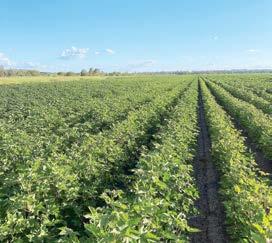
By Fiona Gowers
A tightly-held parcel in one of Queensland’s most productive farming districts is for sale as demand increases for properties with reliable water access.
Acacia, strategically positioned along the Dawson River in Queensland’s highly soughtafter Theodore region, operates as an integrated beef production and irrigation farming enterprise across 1076.4 hectares (including 89.0-hectare special lease).
JLL Agribusiness directors Geoff Warriner and Clayton Smith, with sales executive Fergus Russell, are managing the auction campaign for this property.
“This extensively developed operation offers investors either a turnkey standalone business or strategic integration opportunity for existing supply chains, delivering valuable protection against seasonal volatility,“ Mr Warriner said.
“The Theodore district’s exceptional land quality and soil diversity have established it as one of Queensland’s most productive and tightly held farming areas.“
The property’s water security provides a significant competitive advantage.
“Substantial water allocations - well above district averages - ensure consistent production
capacity regardless of seasonal variations,“ Mr Warriner said.
The operation features more than 216 hectares of irrigated Leucaena supporting grazing activities, while cropping areas accommodate diverse summer and winter plantings including forage crops, cereals, and cotton.
“Considerable capital investment in irrigation systems for Leucaena production and livestock handling infrastructure has optimised operational efficiency while reducing labour requirements,” Mr Warriner said.
Located about 15 kilometres south of Theodore along the sealed Eidsvold-Theodore Road, Acacia provides convenient access to Rockhamp-
ton (180 kilometres northeast) and Dalby (260 kilometres south).
The property’s Theodore proximity ensures excellent connectivity to major transport corridors and key-end markets across northern, eastern and southern regions.
Land classification breakdown

• Flood Irrigation: 204* hectares
• Irrigated Leucaena: 216* hectares

• Dryland Leucaena: 161* hectares
• Grazing: 427* hectares
(*Indicates approximate)
The auction will be held at Theodore RSL Hall on Thursday, 20 November 2025 at 11am (AEST).

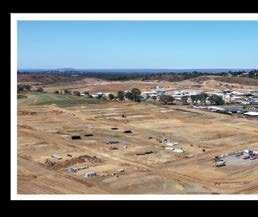
Australian farmland values continued to plateau across the first half of 2025 nationally, but Central Queensland’s median price per hectare rose a whopping 148.5 per cent.
According to the latest report from Bendigo Bank Agribusiness titled 2025 Mid-year Update Australian Farmland Values, Central Queensland’s median price per hectare rose a whopping 148.5 per cent from a mere 13 transactions in the first half of 2025.
Despite the increase, the median price per hectare remains the lowest in Queensland at $1578.
The Central Highlands rose 6.2 per cent for the first half of this year, with 43 transactions recorded, bringing the median price per hectare to $6551.
All regions recorded lower transaction numbers than the last half of 2024 with the exception of the Western region, where nine transactions were made compared to only seven in the back half of last year.
The major drivers of farmland values – commodity prices, varying seasonal conditions and interest rates all played a role in the state-by-state results.
Overall, median price of Queensland farmland fell 3.4 per cent to $9,558/ha in the first half of 2025. This is down 2.8 per cent year-on-year but is still the third highest half-yearly price on record.
The number of transactions was down 10.9 per cent year-on-year, with the 713 transactions recorded the third lowest recorded in more than 30 years.
From a regional perspective, half recorded lifts and half recorded declines.
Keith Dahms, Agribusiness Relationship Manager in Rockhampton commented in the report that there is still appetite for good quality properties in the Central Queensland and the Central Highlands.
“However, high prices are forcing buyers to consider the potential return by taking a longerterm view by considering how a purchase will enhance existing operations, as a transaction may
not appear to make sense viewed in isolation,“ Mr Dahms remarked.
“Most are happy to let the market cool and see whether it will flatten out or decline while working to build their own position.“
Transaction numbers were also reasonably split in the state, with 53 per cent in regions that declined and 47 per cent in those that lifted. Two of the top three highest valued regions declined this year (Southeast and Far North) which account for 37 per cent of all transactions and resulting in a fall in median value at a state level.
Positive seasonal conditions and supportive commodity prices mean many farm operations are reasonably well positioned and are not being forced into selling off land.
High land values are also a consideration, with return from output on the land alone unlikely to be profitable. This means buyers are having to be more selective in acquiring property that will benefit their business and to consider purchases as a longer-term investment, rather than looking for immediate return from production.
Demand for farmland remains and with easing interest rates and positive seasonal conditions, there is potential for Queensland farmland to hold steady or even return to mild growth in the next six months.
The national median price of farmland fell to $9,885/ha, representing a minor dip of 3.1 per cent year-on-year. South Australia and New South Wales were the only states to record growth, with a general trend lower in the median price of farmland at a state level.
Australia’s most valuable farmland by region:
• Tasmania – Northwest and Northern: $25,143/ ha
• Victoria – South and West Gippsland: $24,747/ ha
• South Australia – Adelaide and Fleurieu: $23,651/ha
• Western Australia – Southwest: $18,357/ha
• New South Wales – North Coast: $14,948/ha
• Queensland – North $14,946/ha



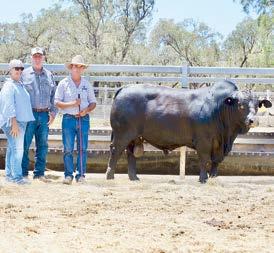
By Breanna Lloyd
Duaringa’s well-known Earlwood Brangus stud owner Mick Madden dominated the sale ring at the 49th annual National Brangus Sale, selling three sires that achieved the top and secondhighest prices of the event.
The sale, held on Monday, 13 October and Tuesday, 14 October, saw more than 190 registered and herd bulls and over 30 registered females go under the hammer.
This year’s bull sale averaged $17,125, grossing $3,014,000 with an 89 per cent clearance rate.
The first top-priced bull was Earlwood Cur-



ran, who sold for $130,000 to Mark and Amanda Salisbury of Bimbadeen Brangus, Monto. The 27-month-old embryo calf was sired by Tannyfoil P79 and out of Earlwood 3759, weighing 892kg.
Matching the top price was Earlwood Tuala, a 24-month-old, 864kg black bull purchased by Brad Comiskey of Lunar Brangus, Emerald.
Selling for the second-top price was Earlwood Critter, which made $125,000 and was purchased by Edward and Kara Quinn of Voewood Brangus, Calliope.
All three top-priced bulls were sired by Tannyfoil P79, who now has five sons to have sold for




six figures.
With more than 30 years of Brangus breeding experience, Mr Madden exceeded his 2024 average of $83,000, lifting it to $90,100 this year.
The female section, held on Monday, achieved a 97 per cent clearance rate, with an average price of $7235 and a gross of $245,999.
Three lots — Barronessa Abstract, Barronessa America, and Rockyview Urvi — all sold for an equal top price of $15,000.
Barronessa Abstract 83D U75, a 24-monthold female 14 weeks in calf, was offered by Jeff Strazzeri of Barronessa Brangus, Atherton, and








purchased by the Radel family of Tarcoola Brangus, Biloela.
Also offered by Mr Strazzeri was Barronessa America 281 U48, a 25-month-old heifer seven weeksincalf,purchasedbyOwenRankineofLake Eacham. Barronessa America was an ET daughter of Barronessa Csonka 281 and by the $1.5 million record-priced bull SAV America 8018.
Rockyview Urvi, a 22-month-old heifer, also sold for $15,000 to Bill and Sharon Walpol of Sandalwood Brangus and Ultrablacks, Bowen. She was offered by Jason Beckman of Rockyview Brangus, Aubigny.





After 20 years delivering containers across Queensland, we’ve learned that the best solutions come from thinking beyond basic storage.
While a container makes excellent lockable storage for your household goods, there are plenty of other ways to put one to work on your property.
Here’s a few…
Mobile workshops that follow the work
Imagine having your tools and equipment right where you need them instead of driving back to the shed multiple times a day. A 20-foot container can be fitted out as a mobile workshop and positioned at whichever paddock you’re working on that season. Add some shelving, a workbench, and good lighting, and you’ve got a functional workspace that moves with your machinery. During critical harvest windows, the time savings alone could justify the investment.
Feed storage that doesn’t feed the rats
Storage sheds work fine until you’re dealing with a mouse or rat plague. Containers offer a completely sealed solution when the doors are shut—raised off the ground with steel construction means no entry points for vermin. If you’re losing seed/feed to spoilage and damage, a few containers dedicated to storage could eliminate those losses entirely. It’s one of those investments that pays for itself quickly when conditions turn against you.
On-site accommodation during busy periods
If you hire seasonal workers, housing them can be a headache. Containers can be modified with insulation, windows, and air conditioning to create basic but comfortable accommodation. They’re not permanent structures, which means there’s often less red tape involved, and they can be relocated or removed when the season ends. For op-

erations that need flexibility with worker housing, it’s worth exploring what’s possible.
Chemical and fuel storage done properly
Meeting workplace health and safety requirements for chemical and fuel storage can be expensive. Containers offer a compliant storage solution—they can be bunded, locked, properly ventilated, and positioned away from other build-
ings. If you need to keep diesel and chemicals separate and secure, modified containers could tick all the regulatory boxes while keeping costs under control.
The key question
What makes these applications work is matching the solution to a specific problem. Containers are versatile, durable, and can handle Queensland’s

tough conditions—but they’re not the answer to everything.
If you’re considering a container for your property, start by asking “what problem am I trying to solve?“ rather than “what size do I need?“ Once you’re clear on the challenge, the right solution usually becomes obvious. And if a container isn’t the best option, that’s worth knowing too!

A powerful Australian film highlighting the often silent struggles of rural life is bringing communities together and sparking vital conversations about mental health in farming regions.
The award-winning film Just A Farmer is currently embarking on a nationwide roadshow, screening in rural towns and agricultural regions across the country. It aims to encourage open dialogue around mental health and suicide prevention in the farming sector.
Written, produced and starring Leila McDougall, the film follows the journey of a farming family grappling with loss and mental health challenges. Its raw and emotional portrayal has resonated strongly with audiences both in Australia and overseas.
Since its release, the film has earned multiple accolades, including Best Narrative Feature at the Iris Global Health Film Festival and the Audience Choice Award at the Saint-Tropez Antipodes Film Festival.
“This film is not just about telling a story, it’s about starting a conversation that is long overdue,” Ms McDougall said.
“Mental health in farming communities is a real issue, and I believe Just A Farmer can help bring much-needed change. We need to stop telling farmers to be more resilient and start showing them the empathy, respect, and appreciation they deserve.”
The grassroots roadshow has gained the support of local councils, farming organisations and mental health advocates, with screenings designed to create safe spaces for people to talk and connect.
Events often include post-screening discussions with mental health professionals and community leaders, offering practical support and breaking down stigma around seeking help.
“We are so proud of the impact Just A Farmer has had, but our work is far from over,” Ms McDougall said.
“This is just the beginning of a larger move-

2.9m / 9.5 under hammer



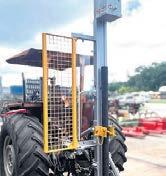


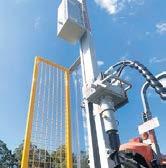








Now Buildings, trusted by Australian farmers for more than 17 years, have just announced their biggest shed sale yet. With a massive $750,000 in discounts and rebates across the entire range, there has never been a better time for Queensland farmers to secure an Australian made shed at an unbeatable price.
Whether you are building for your farm, business, or both, this is your chance to lock in exceptional value. Secure your shed today with a deposit and enjoy exclusive end of year savings, with access to rebates for a limited time. Built for Queensland Conditions Queensland’s climate demands strength, flexibility, and reliability. From scorching heat to heavy rain and wind, every Now Buildings shed is engineered to perform under pressure. Each design
meets or exceeds building code standards, ensuring your investment stands strong season after season.
Made from 100% Australian BlueScope and Colorbond® steel, Now Buildings sheds deliver the durability and corrosion resistance Queensland farmers rely on. Whether you need a hay shed, machinery shed, drive-through design, or workshop, Now Buildings offers site-specific engineering and practical layouts to suit your property and operation.
Australian-Made and Locally Supported
Every shed is proudly made right here in Australia. By choosing Now Buildings, you are not only getting a premium-quality structure but also supporting local jobs and regional suppliers. Now Buildings proudly backs more than 100 rural associations, helping strengthen the communities that power Australian agriculture.


From the first quote to final delivery, you deal directly with the Now Buildings team. There are no middlemen, just straightforward advice and reliable service from experts who understand your needs.
With prices slashed across the entire range, sheds are moving fast. Join thousands of Queensland farmers who already trust Now Buildings to protect their machinery, hay, and livelihoods.
Feel like a winner every time you walk into your new shed.
Call 1300 553 779 or visit www.nowbuildings. com.au to claim your share of the savings today.
Want a brochure? Give us a call and we will mail you one!
Queensland farmers support Now Buildings, and Now Buildings supports Queensland farmers.





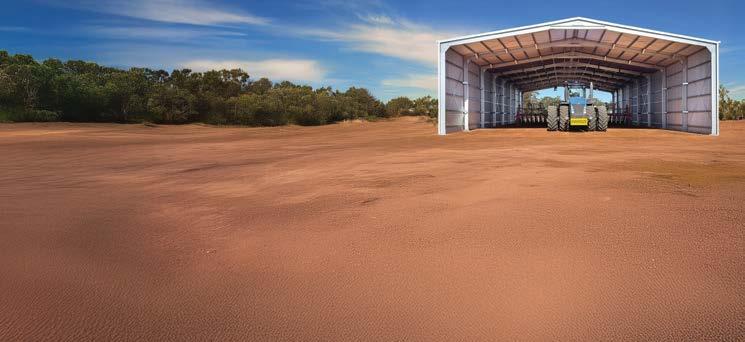









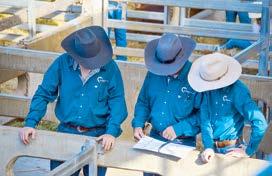
By Breanna Lloyd
The Southern Hemisphere’s largest Brahman sale, Rockhampton Brahman Week (RBWS), was a bidding smash, retaining a total clearance of 96 per cent.
Held from Monday, 6 October to Wednesday, 8 October, the event saw over 750 red and grey Brahman bulls, including 576 polled and scurred, go under the hammer. A total of 712 bulls were sold out of 759, with a sale average of $11,540 and a gross of $8,216,500.
The sale kicked off strongly on day one with the highest-priced grey, Token Playboy1286/3, lot 150, selling for $120,000.
The 31-month-old grey Brahman was offered by Tony and Kathryn Mortimer of Token Brahman, Dalma, and purchased by Peter and Joy Newman of Rathlyn Brahman Stud, Laglan Pastoral Company, Emerald.
Token Playboy was sired by Clukan Baobab, who sold for $210,000 at the 2020 RBWS, and dammed out of Elrose Bling, who sold for $30,000. Elrose Bling is the daughter of NCC Justified, the Australian record Brahman bull who sold for $325,000 in 2017.
Stockman Venturo 767 was the top-priced bull for day two, selling for $70,000.
The 23-month-old homozygous polled IVF bull was offered by the McCarthy family of Stockman Red Brahmans and purchased by Brooke Jerreris, Elrose B Brahmans, Theodore. Day three of the sale saw the top red Brahman, Jileaba Webb, lot 668, sell for $90,000.
The 23-month-old bull was offered by RBWS president Reade Radel and his wife Jill of Injune and purchased by Scott and Coralie Sorley, Mt Callan Brahmans, Dalby.
Elders stud stock agent Mark Scholes and Mr Radel discussed the sales results, touching on the breed’s continuous success over the years, despite some negative comments about Brahmans.
“It has been a fantastic three days. Every day has had around a $12,000 average, and being over 80 per cent clearance is really pleasing to see,” Mr Scholes said.
“There’s been plenty of negative feedback about the breed, but those invested in the breed know that is not correct. This week’s result has absolutely proved that. We’ve seen a lot of buyers who haven’t been here for the past year or two come back this year, and I think that shows the strength of the Brahman job.”
Mr Radel agreed, explaining they do hear negative comments from time to time.
“That’s right, we do hear a bit of negative feedback about Brahmans from time to time,” he said.
“But Mark, every year we sit down here and we say, ‘Well someone forgot to say that to the buyers.’ Overall, it’s been a phenomenal result, and Brahman Week does it every year.”
The pair congratulated the Australian Brahman Breeding Association (ABBA), the organising committee, and the vendors and buyers for another terrific year in the sale ring.
Not only was there national attendance, but also international buyers and vendors, including highlight attendees Benton and Brooke England from England Cattle Co Polled Brahmans, Texas, United States.
In an interview with ABBA board member Stewart Borg, Benton and Brooke said they’d thoroughly enjoyed their time in Australia.
“We’ve been here for several days and what we’ve seen of the Australian Brahman breed so far is something you should be very, very proud of,” Benton said.
“This is something that is so unique and so



and you’re
on the really important qualities like fertility and structure.”


“There
breeding values in them,” he said.
“If we begin using these kinds of bulls on our animals, we would really get some good daily average weight gains.”
By Jane Lowe
For many young Australians, stepping onto a university campus marks the beginning of an exciting new chapter filled with learning, discovery, and independence.
Whether students move away from home or study locally, university life offers a unique opportunity to explore interests, build lifelong friendships, and shape future careers.
University study is more than just attending lectures and passing exams, it’s about developing critical thinking, problem-solving, and communication skills that prepare graduates for the real world.
Students can choose from a wide range of courses in fields such as science, agriculture, business, health, arts, and engineering, tailoring their studies to match their passions and career goals.
Many institutions now combine traditional classroom learning with practical experience, offering internships, research projects, and overseas exchange programs.
These hands-on opportunities allow students to apply their knowledge in real-world settings, giving them a competitive edge when they graduate.
Equally important is the personal growth that comes with university life.
Students often learn how to manage their time, budgets, and responsibilities which are lessons that are just as valuable as their academic achievements.
For regional students, moving to the city for study can also bring new perspectives and lifelong memories.
Universities are continuing to evolve, offering flexible study options and online learning pathways to suit students of all ages and backgrounds.
Whether you’re a school leaver, a mature-age student returning to study, or someone looking to upskill, there has never been a better time to invest in education.
As one local student put it, “University opened doors I never knew existed. It’s not just about getting a degree, it’s about discovering who you are and what you want to contribute to the world.”
Studying at university is beneficial for career advancement, skill development, and personal growth.
A university education can open doors to better job prospects and higher earning potential, while also providing valuable experience through internships and work placements.
Beyond career goals, university offers a unique environment for intellectual stimulation, personal development, and building lifelong friendships Career and Financial Benefits
A university degree is widely recognised as a key to career progression and financial stability.
Graduates often enjoy higher earning potential and access to a broader range of job opportunities.
Many employers seek candidates with university qualifications, valuing the knowledge, discipline, and commitment that come with completing a degree.
Universities also bridge the gap between study

and the workplace by offering practical experiences such as internships, work placements, and research projects.
These opportunities allow students to apply their learning in real-world situations, strengthening their resumes and building the confidence needed to enter the job market.
Skill and Knowledge Development
Beyond career prospects, university study develops essential skills that last a lifetime.
Students learn to think critically, solve prob-

lems creatively, and communicate effectively as these are abilities that are highly valued in any profession.
Courses are designed to build both technical expertise and transferable skills such as teamwork, leadership, and adaptability.
Students also benefit from learning under experienced academics who share insights from the latest research and industry developments. Personal and Social Growth
University is also a time of personal discovery.
It provides a space for students to explore new ideas, broaden their perspectives, and grow as individuals.
The friendships and networks formed during this time often last a lifetime and can become invaluable professional connections in the future.
For many, university is an exciting journey of self-discovery a place to uncover passions, build confidence, and prepare for life’s next chapter.
Whether studying close to home or in a new city, the experience offers opportunities that extend far beyond the classroom.




The Hort Innovation Venture Fund, Australia’s first horticulture-focused venture capital fund, has made its inaugural investment, marking a landmark moment for the sector.
Funding automated disease detection provider, BioScout, this investment signals a new era of support for transformative technologies that will shape the future of Australian horticulture.
Launched in late 2024, the Hort Innovation Venture Fund, delivered in partnership with Artesian Venture Partners, was created to accelerate innovation across the horticulture sector by investing in early-stage, high-growth startups.
This investment in BioScout is backing cuttingedge solutions to revolutionise disease detection and management in horticulture crops.
Brett Fifield, CEO of Hort Innovation, explained what this investment means for the industry: “This investment is about delivering real, on-the-ground benefits for growers. By supporting BioScout’s innovative disease monitoring technology, we’re helping growers access tools to make faster, datadriven decisions that protect crops and improve yields.”
“We’re serious about backing technologies that solve real problems quickly for growers and are thrilled to have BioScout on board to do this. This is just one example of how Hort Innovation Frontiers – which our Venture Fund is funded by – is focusing on the accelerated deployment of research and development solutions to get them into the hands of growers faster.”
Jane Parker, Agricultural Development Man-
ager at McCormick Foods Australia spoke to her experience with BioScout and what this investment could mean for growers: “BioScout technology is developing as a key line of defence against fungal diseases. Further investment will facilitate the extension of the BioScout network to new geographies, increasing grower knowledge of spore behaviour and management.”
Lewis Collins, CEO of BioScout shared his feelings on the investment: “We are very excited about this investment from Hort Innovation as it enables us to further develop and commercialise our world-first disease detection technology. With Hort Innovation’s support we can now deliver even more value to our rapidly growing horticultural customer base and ultimately benefit the entire industry.”
Jordan Jeffery, Investment Principal at Artesian added: “We’re particularly impressed with BioScout’s ability to integrate cutting-edge AI with practical hardware on-farm. Their platform doesn’t just detect disease in real time; it provides growers with the foresight to act before outbreaks escalate. This predictive capability is a gamechanger for horticulture growers, regulators and the broader agricultural value chain.“
This milestone underscores the Fund’s strategic intent to accelerate innovation and deliver tangible benefits to growers nationwide. To read more about the Hort Innovation Venture Fund head to: • https://www.frontiers.au/startups/
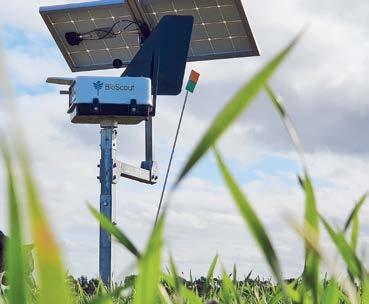
“The Warrego Electorate will benefit from the Crisafulli State Government’s fully-funded Hospital Rescue Plan, with new CT Scanners being delivered to Dalby and Charleville,” Warrego MP Ann Leahy said.
“Along with members of the local communities, I have fought for additional CT Scanners for the electorate.”
“I welcome the commitment from the Crisafulli Government who are now delivering this life saving equipment,” Ms Leahy said.
Ms Leahy said these CT Scanners will help support the national lung cancer screening program.
“Lung cancer is one of the leading causes of cancer death in Australia and CT Scans are critical for early diagnosis.”
“People’s travel time to have scans will be greatly reduced with the introduction of CT Scanners in Dalby and Charleville,” Ms Leahy said.
“This equipment will assist patients with more accurate diagnosis following accidents and emergencies and reduce the trauma of having to be transported to other locations which they are unfamiliar.”
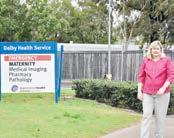
Leahy
“These Scanners will also support the hardworking doctors and nurses by giving them state of the art equipment to do their job,” Ms Leahy said.
Ms Leahy said Queenslanders voted for CT Scanners in Charleville and Dalby at the last election and the Crisafulli Government is now delivering that equipment.

•1.2MX2.2M
•8RAIL -GRADUATED
•2.5MMOD -GALVPIPE
•PINSINCLUDED
PACKBUYS-93 -$90EA LOOSEBUYS -$100EA
•GOATPANELGATE -$250
GATES-GALV
•10’-3M -MESH -$120
•12’-3.6M -MESH -$140
•14’-4.2M -MESH -$160
•10’-3M -5BARLIGHT -$140
•12’-3.6M -5BARLIGHT -$160
•14’-4.2M -5BARLIGHT -$190
•12’-3.6M -5BARHEAVY -$180
•14’-4.2M -5BARHEAVY -$210
BARBEDWIRE
•2.5MM-IOWA-400MROLLS PALLETBUYS-27ROLLS -$125EA
SINGLEROLLS -$135EA
•1.8MM-HIT-500MROLLS PALLETBUYS-36ROLLS -$115EA
SINGLEROLLS -$125EA
FENCEPOSTSPICKETS
•165CM-5’6”BLACK-HEAVY -$7.50
•180CM-6’BLACK-HEAVY -$8.50
•180CM-6’HDG-HEAVY -$9.00
PRICEBASEDONBUNDLESONLY CATTLECABLE
•8.2MM-7STRANDGALV
•400MX150KG -$550
HINGEDJOINT/FIELDFENCEFIXEDKNOT CATTLEGRIDHEAVY
•4MX2M-800KG -$2700
CONCRETEABUTMENTS
•4M-3000KG/PAIR -$1800
GALVGRIPMESHWALKWAY
•3000X600 -$200
•3000X750 -$220
BLACKPOWDERCOATED RHSSQUARETUBE
•75X75X3
•3M/LENS
$45/LEN 200-IN-STOCK STRAINERPOSTS
•2.4M- 80NBX4MM-GALV -$65
•3M- 80NBX4MM-GALV -$75
•2.4M- 80NBX4MM-BLACK -$60
•2.9M- 80NBX5MM-PTD -$70
•3M- 80NBX5MM-PTD -$75
BUNDLES19LENSONLY BLACKRUSTY
366-3100MM-40NBX3.2MM -$22 BUNDLES-61-ONLY PIPE-NEAR-NEW $/LEN
231- 6.5M-20NB-MGPE -$18 STEEL PLATE-NEARNEW
•2400X1200X1.6 -$120
•3000X1500X3 -$260
•3000X1500X6 -$550
•3000X1500X25 -$2000
GALV.PIPEMEDIUM
•65NB-76MMODX3.6MM
•6.5MLEN/37-BUNDLE $70CHEAPERTHAN5ONB BUNDLESONLY

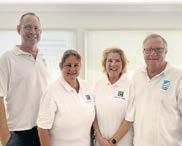

By Maddison Richards
Australia covers a large area of land, and to be named best in Australia is an outstanding achievement.
At the Royal Adelaide Show earlier this year, 30 August to 7 September, Year 12 Murgon S.H.S. student Kaitlyn Barber, competed in the National Finals Beef Cattle Paraders on 4 September, representing Queensland.
Of the finalists, all representing a state or territory, Kaitlyn placed third, which is an amazing accomplishment.
“Being third in Australia definitely feels a bit surreal,” Kaitlyn said. “I am very grateful and proud of how far I have come. I feel very accomplished in this achievement I have achieved and cannot be happier.”
Kaitlyn said she felt the competition saw many, very competitive people from all over Australia attend, which pushed her to do better.
“My highlight of competing was having the opportunity to compete with people around my age that are from all over Australia and being able to meet new people in the cattle industry,” she said. “I feel like competing with others is a great opportunity as you get to learn new things about how other people lead and what other judges are looking for.”
The State finals in Queensland was harder than the National finals, was how Kaitlyn felt.
She explained that the Nationals was a hard competition but she felt more relaxed than when she competed in State finals in 2024.
In Queensland, Kaitlyn said she had to lead under the sky, rain, hail or shine, whereas at Nationals, she showed under a big tent for everything.
“It was a bit of a different situation and was a great experience,” she said.
To add to her list of recent accomplishments, Kaitlyn recently won the Overall Champion Leader at the school Hoof and Hook competition.
Her next steps in her cattle showing career, Kaitlyn would love to one day start her own stud in the future and show her own cattle.
Before then, she’s happy to continue to help the younger generation thrive, and wants to help the kids do the best, as she loves to see the younger kids coming through the cattle showing circuit.
As a Year 12 student, Kaitlyn’s plans for after school include attending university to study a Bachelor of Teaching (Early Childhood) and to continue showing cattle and running the family farm.
“I am very passionate about the cattle industry, and I would love to pass my knowledge on to the younger kids that are coming up,” she said.
Kaitlyn would like to thank everyone that has supported her on this journey.
“There are way too many people to name, but I do really appreciate you all,” Kaitlyn said. “I would not be where I am today if it wasn’t for the critics and the feedback I have received over the last five years.”
Her message to those looking to enter the cattle showing industry, “just remember, if you don’t win a ribbon don’t be upset, ask around and see what you can do to improve and continue to strive for the top, but also have fun.”




On International Day of Rural Women (15 October), the Australian College of Rural and Remote Medicine (ACRRM) celebrated the women who keep rural and remote communities thriving — and the Rural Generalists who deliver the care that helps make it possible.
This year’s theme, “Rural Women Cultivating Good Food for All,” highlighted the powerful role women play in sustaining rural Australia — from putting food on our tables to leading in healthcare, education, and community life.
ACRRM President Dr Rod Martin says rural women are the backbone of strong communities, and access to quality healthcare close to home is critical to their wellbeing.
“Rural Generalists are delivering the kind of
care women need — the right care, in the right place,” Dr Martin says.
“They provide maternity, reproductive and preventive health services that support women through every stage of life, from adolescence to motherhood and beyond.”
Dr Martin says ACRRM is proud to have a strong female membership and to support the doctors working alongside rural women every day.
“When we invest in rural women, we invest in stronger families, stronger communities, and a stronger future for rural Australia,” he says.
“Today, we celebrate the women growing healthy communities — in every sense of the word.”

By Fiona Gowers
A deeply moving day of connection, storytelling and community was experienced at Motherland’s latest rural event in Quilpie on 11 October.
Held at the Quilpie Shire Town Hall, more than 110 rural mums from across western Queensland attended the event, which was a heartfelt response to the challenges many rural families have faced in the wake of devastating floods.
The gathering gave mums an opportunity to take a breath, connect with each other and be reminded they’re not alone on their motherhood journey.
Motherland founder and CEO Stephanie Trethewey hosted the event, which featured an emotional panel with three Queensland rural women including Shona Underwood, Diane Dowrick and Tash Johnston from Farm Angels.
Annabelle Williams OAM, Paralympic gold medalist and international motivational speaker delivered a powerful keynote speech, focusing on the importance of community and the impact and ripple effects of kindness.
“This event was about lifting rural mums up and ensuring they know that they are not alone, especially after such a challenging year,” said Stephanie.
“To have so many rural women in one room, laughing, crying and connecting - that’s what Motherland is all about. The energy in Quilpie was extraordinary.”
In a powerful show of solidarity, 50pc of all funds Motherland raises are being donated to fellow charity Farm Angels, supporting their vital work helping families doing it tough in the bush.
Guests enjoyed lunch, welcome drinks and a special performance by illusionist Josh Norbido to close the day.
There were also stalls from support organisations such as The Boarding School Collective, Women’s Health and Equality Queensland and the Charleville Hospital.
The event was brought to life by a dedicated group of local volunteers and generous sponsors from across the region.
Motherland continues to unite rural mums annually through events, with fundraisers held in Kingaroy and Clermont this year, as well as Denilquin in NSW and Darkan in Western Australia.
* To learn more about Motherland or to support the charity’s work, visit www.motherlandaustralia.com.au.



JBS’s Global Chief Livestock Scientist, Dr Sarah Klopatek, will tackle the question of how to correctly measure the impact of cattle and climate, as part of a power-packed lineup of speakers at Cattle Connect.
Cattle Connect, to be held at the Dalby Showgrounds on November 11-12, is the flagship industry event of Cattle Australia (CA), bringing together producers, processors, researchers, industry leaders and international experts to share knowledge and new ideas to shape the future of the industry.
Dr Klopatek will set the tone for the discussion of sustainability issues at the Cattle Connect Conference, sponsored by Land Watch Australia, speaking on the topic of ‘Valuing our impact on the climate, correctly’.
“Dr Klopatek is internationally recognised for her research on regenerative agriculture initiatives, carbon accounting, life cycle assessment development, and land use change,” CA Chief Executive Will Evans said.
“Having researched at world-class research universities, including Texas A&M and the University of California Davis, her expertise in beef sustainability is now being called upon by the United Nations Food and Agriculture Organisation (FAO).
“Her involvement in Cattle Connect will

make a significant contribution to properly understanding the role of cattle in our environment and the debate around livestock’s role as part of the climate change solution.”
CA has been leading calls for recognition by the Australian Government of the biogenic carbon cycle in emissions accounting systems to more accurately reflect the contribution of
the livestock industry to climate change, and to provide farmers with the means to participate in carbon markets.
Also on the program to discuss sustainability and environment issues are Woolworths Group’s General Manager Sustainability, Bel Quince, and Assistant Minister for Agriculture, Anthony Chisholm.
Ag education will be another hot topic with presentations from Anthony Lee, CEO of Australian Country Choice, and Luciano Mesiti, CEO of the Primary Industries Education Foundation Australia (PIEFA).
Outside the conference hall, there’ll be agtech demonstrations from the likes of Warrego Water Services; working dogs, livestock handling and heifer conformation workshops; retail exhibitors including Kidman Clothing; interactive displays on the RaboTruck, along with a barista to keep everyone caffeinated.
Entertainment will include the CA Cup Campdraft, sponsored by Ceres Tag, and Meat & Livestock Australia chef Sam Burke’s ‘Showstopper Steaks’ Sundowner Show, which will ensure all visitors enjoy the very best that beef has to offer.
To register for Cattle Connect, visit cattleaustralia.com.au



Where your dreams of Cottages and Tiny Homes meet the fine print — and the fine print meets a friendly handshake.
With over 30 years of experience in the construction industry, we know what it takes to deliver safe, compliant, and beautiful spaces. Our goal is simple: to give you clarity and confidence when choosing your perfect Cottage or Tiny Home.
Why choose Cottage Cabins and beware of cheap imports
Not all imported cabins are built to Australian standards. Before buying elsewhere, ask:Is it structurally modified for Australian requirements?
Does it come with an Australian engineer’s structural assessment?
Is there a Form 15 signed by an Australian structural engineer?
Is it rated to withstand N2 or N3 wind speeds?
At Cottage Cabins, safety comes first. While our cottages are imported, each undergoes significant structural modifications by Australian engineers to meet strict local safety standards. Don’t compromise on your family’s safety — choose wisely.
Designed for Accessibility Our cottages are also wheelchair accessible, making them suitable for a wide range of lifestyle needs.
We provide complete support from concept to completion, including, Site Visit & Assessment, Site Preparation, Engineering & Access, Foundations & Footings, Decking & Landscaping, Relocation & Extension of Services, Installation & Assembly, Interior Design Assistance.
Built for Australian Conditions, Our cottages are designed to comply with Australian Design Rules (ADR), making them road-registerable caravans when placed on trailers.
We design and manufacture our own 100 per
cent Australian-made trailers, tailored for our range of tiny homes and compliant with VSB1 standards.
This gives you the flexibility to classify your cottage as a caravan rather than a permanent dwelling when needed.
Regulations vary across councils and states. For example, in Queensland, some councils allow the construction of a granny flat (secondary dwelling) up to 80sqm without planning approval — provided certain conditions are met.
Before purchasing your dream Cottage: Always consult your local council to confirm approvals and understand that our cottages are not classified as Class 1A buildings and may not meet permanent dwelling standards.
For anything beyond temporary or caravan use, you’ll need to check compliance with the National Construction Code (NCC) and other relevant building standards.
A Word of Caution, Some resellers may advertise cabins as ADR-compliant caravans when they are not. Others may sell cabins that fail to meet NCC requirements. With Cottage Cabins, you can be confident in the safety, compliance, and quality of your investment.
Warranty Coverage, we stand by our workmanship with strong warranty protection:
• 3-Year Structural Frame Warranty, covers all structural frames. Repairs or replacements will be handled by Cottage Cabins at our discretion.
• 6-Month Fixtures, Fittings & Finishes Warranty, covers selected fixtures and finishes. Repairs or replacements will be carried out at our discretion.
• (Excludes transport/travel costs, removal or reconnection of services, and furniture handling. Normal wear and tear is not covered.)




By Jane Lowe
Kandanga Valley is gearing up for its 6th Annual Summer Bull Sale, to be held on Friday 6 December at the home property “Warravale”, nestled in the picturesque Kandanga Valley, 32km southwest of Gympie.
A total of 65 quality young Charolais and Charbray bulls will go under the hammer this year, representing the depth of breeding and selection that the Mercer family has built their reputation on.
Currently running around 1800 registered cattle across both breeds, the Mercers have the luxury of being extremely selective when preparing bulls for sale.
This year’s hand-picked line-up includes 40 Charolais bulls (24 polled) and 25 Charbray bulls (13 polled or scurred) all showcasing the soft muscling, structural soundness and temperament that buyers have come to expect from the Kandanga Valley program.
“In both breeds there are quality bulls that would suit stud or top-end commercial enterprises,” said John Mercer. “From top to bottom, every bull displays exceptional muscling and bone, and they’re ready to go straight to work.”
John also noted that these young sires “by no means play second fiddle to our July sale bulls”, highlighting their weight-for-age, early muscling and natural doing ability as this is all achieved
without overfeeding.
Buyers can expect bulls backed by strong pedigrees, including Palgrove Lombard (P), Ascot Quorum (P), Moongool Qadir (P) and ANC Q Prince in the Charolais draft sires known for adding punch, growth and early maturity.
In the Charbray offering, there’s something for every program – from exceptional golden polled bulls suitable for stud work through to higher Brahman-content types built for tougher environments, offering that extra bone and muscling.
Influential Charbray sires represented include Trifecta Prince (P), Kandanga Valley Quilpie (P) and the impressive Gracemere Great Northern (P) an outstanding polled Brahman bull making
a real mark on the herd.
All bulls are vaccinated for Vibrio, 3-day sickness, blooded and 7-in-1, and come with semen morphology results, weight and fat/muscle scans, and for Charolais, comprehensive EBVs with several with particularly impressive figures.
“This is one of the very best Charbray line-ups we’ve ever presented,” John said. “We strongly recommend an inspection.”
The sale will commence at 10am, with Nutrien and Shepherdson & Boyd as selling agents.
So if you’re chasing weight for age, muscle, bone, and longevity, mark your calendar as the Kandanga Valley’s Summer Sale is where you’ll want to be this December.




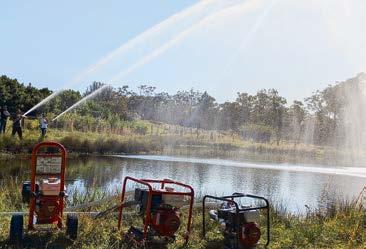
By Aussie Pumps Australia
When it comes to climate, there is no normal. We can see the possibility of a fire season from hell ahead, with either flood or drought as part of the equation. Our Chief Engineer has been working on new product developments over the Winter and are now launching new pumps that can make a difference to the three climate issues, drought, flood and bushfires. WHAT A WHOPPER!
One of the new pump concepts designed over the last months is Aussie’s QP205HF/GX200. It’s based on the Aussie Fire Chief, the pump that changed the way people think about high pressure bushfire fighting.
We developed a new impeller and volute that provides a real difference. The pump was nicknamed the “Whopper” because a farmer saw it at a field day recently and saw the performance curve. His comment … “What a Whopper!”
The pump delivers more water at pressure. The pump is priced way below list prices of companies like Davey and Onga but produces up to 480 litres per minute and a maximum head of 67 metres.
In a drought, it can transfer water fast from dam to dam and in a heavy downfall can do the same thing to maximise water retention. FIRE SEASON AHEAD … ENTER THE ‘IMPOSTER’
You don’t need to be a weather forecaster to realise that we are heading for a blistering summer. Seeing the events of the Northern Hemisphere over their summer, you get a taste of what it’s going to be like with 40 plus degree temperatures.
The CFA and the volunteers are well aware of the danger and again, Aussie has worked hard to provide advanced products that will perform better than any other similar equipment. A new version of the Fire Chief that has extraordinarily high pressure is part of the work we have been doing.
We worked with Honda to match the GX160 5.5 hp to an Aussie Fire Chief that will now deliver up to 90 metres head with a single impeller. That performance is normally equated to a twin impeller pump.
It’s nicknamed the “IMPOSTER” because it’s a single impeller pump that think’s it’s a twin. That means a lower price point with a huge single 7” impeller that enables the pump to outperform all competitors.
The pump comes in a powder coated steel frame which makes it easy to handle, or it can be mounted on Aussie’s Fire Cart.
CROP PROTECTION THE AUSSIE WAY
Aussie’s new Brigade Boss series of high pressure pumps include a range of twin impeller units that have real capabilities for crop protection. Aussie’s new 3” x 3” high volume, high pressure Mr T twin impeller product line is available with Honda electric start petrol engine or, Yanmar diesel drive. It sets new standards

in performance.
The QPT305SLT/GX390E twin impeller pump with electric start produces an astonishing 200 lpm at 80 metres head.
That’s quite an extraordinary performance, considering cropping farmers all know that it’s how much water you can throw at a fire fast as well as the pressure that can save a crop or for that matter, even a header.
In its diesel configuration, considered by many farmers to be safer than a petrol engine during harvest, it also has the same pump configuration, in a steel frame and powered by 10 hp Yanmar electric start diesel engine. Again, the pump’s performance is amazing with 150 lpm at 80 metres head. That is the equivalent of over 100 psi.
With the right hose kit and nozzle arrangement, crop protection can be much more effective but, with the right equipment.
TOWERS POWER EQUIPMENT IS FIRE READY!
Aussie “Gold Distributors” Towers Power Equipment are excited about the new ‘Imposter’ and ‘Whopper’ fire pumps hitting the market this year. The Fire Chief is regarded as the finest lightweight portable fire pump. Best of all, it is backed up with Aussie’s five year pump end warranty.
Get fire season ready with a copy of Aussie Pumps Bushfire Survival Guide. It provides loads of valuable information, including details of household protection as well as livestock and
crop protection, with pumps designed for extraordinary performance.
“With the fire season just around the corner, now’s the time to get prepared and the friendly team at Towers Power Equipment is here to help”, says Towers Power Equipment, Rowan Lowe.
“Aussie’s firefighting pumps are built tough to protect homes, farms, and families when it matters most. Whether you need advice, a new pump, or just want to make sure you’re ready, the Towers Power crew have the gear and knowhow to get you sorted,” said Rowan.
Visit the team at Towers Power Equipment in Charters Towers or give them a call on (07) 4787 1923. To find your nearest Aussie Pumps dealer, visit aussiepumps.com.au


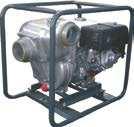





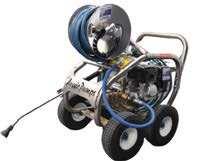

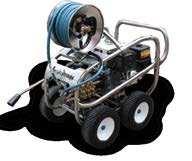






The Maranoa played host to the 20-year celebration of rural generalist practice in Queensland.
The forum came after positive news that Rural Generalists (RG) will now be formally recognised as a specialist medical field within general practice in the Australian healthcare system following an announcement by the Minister for Health and Ageing, Mark Butler MP.
As GPs with extended scope via a year of additional training in emergency medicine and a selection of disciplines needed in rural communities such as child health, mental health, surgery, and obstetrics, Rural Generalists provide invaluable healthcare to their communities.
This is a positive step forward in making the rural generalism career pathway more visible and ensuring that RGs are always appropriately remunerated for the vital work they do in rural and remote communities across Australia,” RACGP President Dr Michael Wright said.
“We must keep pushing forward to make sure we have the right funding incentives in place that allow them to take on additional training and additional skills, including working in local hospitals, and much more.
“RGs are the bedrock of towns nationwide, and it’s only fair that their profession is now dis-
tinctly recognised as a vital part of our healthcare system.”
The Queensland Rural Generalist Forum held from Wednesday to Friday, 1 to 3 October in the Roma Cultural Centre was a great time for all as an array of laughter, conversation and education was had - all under a theme of framing the future.
Forum speaker and spokesperson for Major Projects, Stakeholder Engagement and Advocacy Deputy Mayor Cameron O’Neil said the forum was a great opportunity to talk about what the future holds in the medical field.
“Seeing the 160 strong group of medical professionals come together to celebrate the success of the last 20 years of rural generalisim while setting the pathway for the next 20 illustrates the strength of this program in providing healthcare to rural and regional Queensland,” Cr O’Neil said.
“It all started in Roma in 2005 and was great that the region could host this milestone forum again.”
“Maranoa Regional Council is committed to working with the sector, our South West Hospital and Health service, Governments and the broader community to ensure our region has access to the best possible health care.”




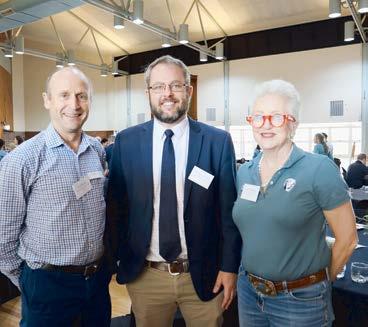




The Talgai Santas team has expressed its sincere appreciation to all buyers, underbidders, and agents who supported their first Talgai Online Production Sale, which delivered outstanding results and a 100 per cent clearance.
All 18 bulls offered were sold to total clearance, averaging $8666, while three lots of commercial heifers averaged $1600 per head an outcome that left the Gadsby family delighted.
Lindsey Park Pty Ltd secured the top-priced bull, Lot 2, Red Oak Ultimate (PP), for $18,000, while Jay Hurlock of NTS Group Pty Ltd purchased Lot 1, Talgai Union Jack (PP), for $12,000, the second-highest price of the sale.
“The success of this sale is a true testament to the hard work and dedication of Garth, Carolyn, Rhys, and the entire team at Bartholomew & Co Auctioneers your efforts have not gone unnoticed and are deeply appreciated,” said Mal and Chick Gadsby, representing Talgai Santas.

$21,000 to Bob Lord, “Kilterry” Julia Creek, with classified bulls averaging $13,000.
Across both sales, ten of the bulls were PP and the remaining twelve were polled.
A special mention was made to the Boonah State High School Cattle Club students for their ongoing assistance throughout the year.
“Your contribution has been greatly appreciated,” said the Talgai team. “Moments like this remind us why we do what we do.”
they were very excited with their win.
Cliff Shelley of Freestone Feedlot got a second with Talgai Santa steers that he had purchased from Talgai at the Santa Gertrudis Show and Sale at Beaudesert earlier in the year.
The Talgai Santas team expressed their gratitude once more to all involved and said they are humbled by the support shown and proud of what has been achieved, looking forward to building on this success in years to come.
Talgai Online Production Sale Summary
• Top Price: Red Oak Ultimate (PP) – $18,000 (Lindsey Park Santa Gertrudis Stud)
• Average (Classified Bulls): $9900
Gratitude was also expressed to the buyers and underbidders who supported Talgai at the Brisbane Valley Santa Gertrudis Sale, where four classified bulls were sold — again achieving a 100 per cent clearance.
The top-priced bull, Talgai Uncle Sam, sold for
The Gadsby family also extended their thanks to Toro Photography’s Lacey McCabe and Aidan Richters for their exceptional video production work, which played a key role in enhancing the advertising campaign, along with the AuctionsPlus team for their professional support.
Adding to their success, Talgai also strengthened their breeding program with the purchase of Rockingham Ulrich U96 (P) from the Rockingham Santa Gertrudis Stud for $16,000. Ulrich is a son of Waco Sonny S136 (P), and the team looks forward to the promising progeny expected from this exciting new bloodline.
The Beef Classic Show & Sale was held at Moreton on Thursday 16 October and Talgai Santas won two first and a second with home breed steers.
They had one entry in a single steer class section and came away with a second and Chick said

• Average (Commercial Bulls): $7125
• Heifers: $1600 per head
• Clearance: 100 per cent
Brisbane Valley Sale Summary
• Top Price: Talgai Uncle Sam – $21,000 (to Bob Lord, “Kilterry” Julia Creek)
• Average (Classified Bulls): $13,000
• Clearance: 100 per cent





Agriculture in Goondiwindi is the region’s dominant industry, combining dryland and irrigated farming with extensive cattle grazing.
The area is widely recognised for producing some of Australia’s finest cotton and wheat, along with other major grains such as sorghum, barley, and canola.
Wool and beef production also play vital roles in the local economy.
Blessed with fertile black soils and supported by a reliable water-sharing network, Goondiwindi stands as one of Australia’s premier agricultural districts, a place where tradition, innovation, and sustainability go hand in hand.
Key Agricultural Activities and Products
Cotton:
Cotton is a major crop in the district, particularly during years of good water availability. Many local families have been involved in cotton farming since the early days of the industry, developing strong expertise and contributing significantly to regional production.
Grains:
Winter cereals such as wheat and barley, and summer crops like sorghum, form the backbone of Goondiwindi’s broadacre farming.
The 2024/25 harvest season alone saw more than 136,000 metric tonnes of grain stored locally a testament to the area’s productivity and efficient supply chain.
Beef and Wool:
The surrounding grazing lands support thriving cattle herds and wool-growing enterprises, producing high-quality beef and fine wool for both domestic and export markets.
Specialty Crops:
Diversification is also evident, with farmers growing other profitable crops such as canola and chickpeas, reflecting the adaptability of Goondiwindi’s farming systems.
Agricultural Resources and Infrastructure
Soils:
Goondiwindi’s agricultural strength begins with its deep, fertile, black self-mulching and crackingclay loams soils ideally suited for a wide range of crops and pastures.
Irrigation:
A mature irrigation network, including both supplemented and un-supplemented entitlements and on-farm storages, underpins the region’s cropping success.
This infrastructure enables producers to make the most of every drop when water allocations allow.
Key facilities such as Coolmunda Dam play an essential role in delivering irrigation water to the district, ensuring the region remains productive even through challenging climate conditions.
Economic Importance and Innovation
Employment and Economy: Agriculture, forestry, and fishing are the largest employment sectors in the Goondiwindi region, supporting more than 1,300 jobs.
This deep-rooted industry remains the economic backbone of the community.
Export and Connectivity:
Recent investments in infrastructure including Wellcamp Airport and the Toowoomba Bypass have expanded export opportunities, allowing Goondiwindi producers to reach national and international markets more efficiently.
Ag-Tech and Sustainability: Goondiwindi is increasingly becoming a hub for
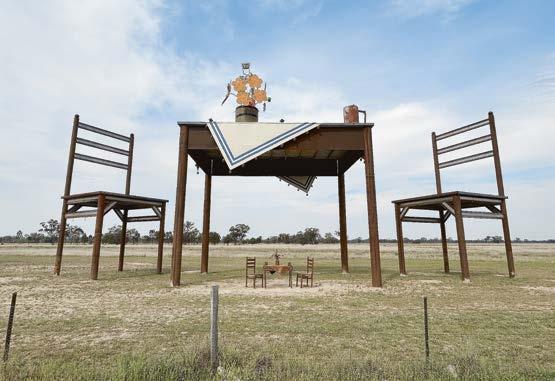
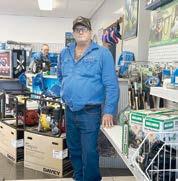

agricultural innovation.
Farmers are embracing ag-tech solutions, data-driven decision-making, and regenerative practices aimed at improving soil health, water efficiency, and long-term sustainability. What to See
Gunsynd Statue:
No visit to Goondiwindi is complete without seeing the statue of Gunsynd, the famous “Goondi-
Grey.”
and sporting spirit.
The Agricultural Landscape:
The region’s sweeping fields of cotton, wheat, and sorghum form a breathtaking backdrop a living gallery of Goondiwindi’s agricultural success story.
Angus Wilson and the Art of Goondiwindi
Coat of Arms – Australia (2014):
Built in 2014, the Coat of Arms is a monumental sculpture marking the entrance to Goondiwindi from the Cunningham Highway.
Created by local artist Angus Wilson, the piece reflects his love for reusing old materials and transforming them into striking works of art. Several of Wilson’s distinctive sculptures can be found throughout the region, celebrating both creativity and community spirit.
Once Upon a Time (2019):
Located beside the Coat of Arms, Once Upon a Time is a collaborative artwork from 2019 that reimagines discarded objects into a whimsical installation. Surrounding the sculpture are Australia’s infamous white ibises, while the words “Once Upon a Time” painted by local school students add a touch of storytelling and local pride.
The Concrete Heads:
Five towering concrete heads, named Matthew, Mark, Luke, John, and Lot’s Wife, line the fence nearby.
Weighing an impressive twenty tonnes, they are dramatically illuminated at night, offering an unforgettable sight for visitors.
Smoko in the Meadow:
Angus Wilson’s latest work, Smoko in the Meadow, features a larger-than-life kitchen table with flowers in a vase and a coffee mug with a lifesized version tucked beneath.
The piece captures the warmth of rural life, honouring the everyday moments that connect community, creativity, and country living.


If you’ve driven past the Black Truck & Ag branch in Goondiwindi lately, you’ve probably noticed some exciting changes taking shape.
The well-known dealership, part of the Harvey Black Group, has recently expanded to include a brand-new Isuzu UTE extension a development that marks an exciting new chapter for the local team and community.
For over 20 years, Black Truck & Ag Goondiwindi has been a trusted name in the region, led by long-time Manager Michael Watt and supported by a loyal, hard-working crew across sales, service, and parts.
Known for their friendly professionalism and deep local ties, the team has built lasting relationships with customers who rely on them season
after season.
The lead-up to harvest has been especially busy this year, with the team managing the predelivery of the world’s largest and latest New Holland CR11 header, alongside multiple CR9.90 combines the true workhorses of the New Holland range. It’s a testament to the team’s efficiency and dedication.
Behind the scenes, the service department has been running like clockwork, keeping local operations moving smoothly and ensuring machines are ready when they’re needed most.
The new Isuzu UTE extension has added even more excitement around the branch.
It’s a sign of growth, confidence, and continued investment in the region something both
staff and customers are proud to see.
With Isuzu’s reputation for reliability and strength, and Black Truck & Ag’s commitment to top-tier service, the expansion is already drawing strong interest from locals looking for a dependable vehicle backed by a team they know and trust.
What really sets the Goondiwindi branch apart, though, is its people.
Many of the staff have been with the company for years, creating a genuine family atmosphere where teamwork and good humour are part of daily life.
Whether it’s in the workshop, out onfarm, or at the front counter, there’s a shared sense of purpose to serve the community with
integrity and care.
Outside of work, the branch continues to give back, proudly supporting local events, fundraisers, and charities that make Goondiwindi such a great place to live.
As the Harvey Black Group continues to grow with branches stretching from Gatton to Roma, Dalby, Chinchilla, Toowoomba, and Moree the future looks bright.
The Goondiwindi team is on the lookout for new staff to join them across departments and be part of this exciting expansion.
It’s a great time to be part of the Black Truck & Ag family where community, opportunity, and growth come together in true country style.



From Toowoomba and Surat Basin Enterprise Fire and Flavour, held at The Walton Stores in Toowoomba, delivered a vibrant celebration of Australia red meat and craftsmanship.
Attendees were treated to a dynamic showcase of premium beef cuts expertly broken down, live cooking demonstrations and a gourmet lunch that celebrated the versatility and quality of local Darling Downs beef.
The event was hosted by Meat and Livestock Australia Corporate executive chef Samuel Burke, master butcher Kelly Payne, head of culinary at dnata Catering and Retail Rob Smithson, and chef and leadership coach Glenn Flood.
The event was about more than just cooking, it was about connecting people to the story behind the meat, from paddock to plate.
TSBE general manager – Food Leaders Australia, Rowie Beveridge said the event was an opportunity to celebrate Australian beef and demonstrate the versatility of different cuts.
“With exceptional quality currently available, there’s never been a better time to enjoy MLA graded beef,” Ms Beveridge said.
“As we head into the festive season, we’re helping to show how beef can have its place as a centrepiece of celebration.”
Corporate chef and foodservice business manager at Meat and Livestock Australia, Samuel Burke said beef is a premium product and when prepared with confidence, it becomes more than just a meal, it becomes an experience
“Cooking over a fire pit, serving generous share plates and pairing with vibrant sides creates a festive, balanced and health-conscious meal that brings people together,” Mr Burke said.
“In a time when cost-of-living pressures are front of mind, beef offers a sustainable and costeffective alternative.
“We want Australians to feel confident using beef in their festive meals and to understand the value and sustainability behind every cut.”
Fire & Flavour was held alongside the 2025 Darling Downs Beef Battle, which was on Thursday, 16 October 2025.
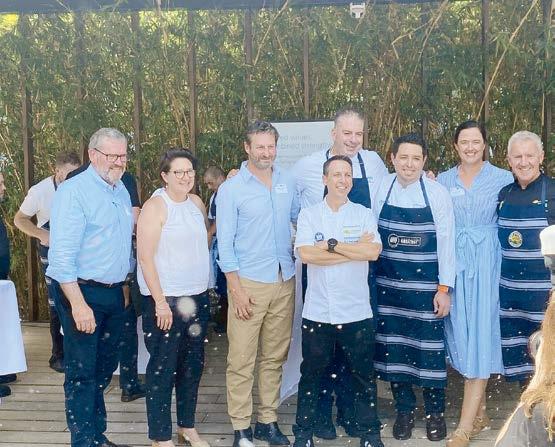
This story first appeared on GrainCorp’s website www.graincorp.com.au
As harvest ramps up in Central Queensland, GrainCorp’s network springs into action – and so do our people.
Each year, employees from the southern part of our network pack their bags and head off to support operations at sites north of home.
We call them our harvest nomads – and few embody the spirit better than Victorian grain handlers Brady Alexander and Buster McCartney.
Between them, Brady and Buster have travelled the length of the east coast, taking on secondments that support busy harvest sites while building their own skills and connections across the network.
This year, they’re heading north from Nhill and Lillimur in Victoria to Mt McLaren, our northernmost site in Central Queensland.
Brady’s first secondment was in Thallon in 2020, and since then he’s worked harvests from Oaklands in NSW to Yamala in QLD, often alongside Buster.
“Every site is different,” Brady says. “You meet new people, learn new ways of working, and get a real appreciation for how the whole network fits together.”
Buster, who’s been with GrainCorp for 14 years, has taken part in so many secondments he’s lost count.
“I’m away for at least two or three months every year,” he says. “I’ve worked everywhere and back again.”
For Buster, secondments are about more than travel. They’re a chance to share knowledge, uphold standards and support new team members.
“You get to work with lots of different people, including casuals and backpackers, and help show them the ropes,” Buster says. “You don’t take shortcuts, and you help others see why that matters.”

Brady agrees: “You end up learning just as much as you teach – not to mention the perks of travelling to places you might not have visited otherwise and meeting people from all walks of life.”
Secondments are a key part of how GrainCorp
flexes its workforce during harvest, providing opportunities for employees to grow, collaborate and contribute where they’re needed most.
It’s not just our northern sites that benefit from secondments, as harvest progresses and
moves down the east coast there’s opportunities for our people to do the same.
As they get stuck into another Central Queensland harvest, Brady and Buster are looking forward to new faces, familiar challenges and a few more stories to add to their growing collec-



By Jessica McGrath
Monto’s Burnham family are proud to invest in the future of agriculture.
Carly and Grant Burnham and their four children Lily, Ruby, Knox and Quad are organic beef producers at their property Bonnie Doone, which is west of Monto in the North Burnett.
The family were thrilled to receive the 2025 Australian Government Climate Innovation Award at the 2025 Landcare awards on Tuesday, 23 September.
Judges noted the family’s experience in ecological agriculture and soil carbon sequestration.
“We were pretty amazed and delighted,” Carly said.
“It’s such a good story for agriculture that we can be producing healthy and nutritious feeds and be improving outcomes for the environment in a real way.
“It gives us so much hope for the future of agriculture.”
Lily and Knox attended the awards dinner on the family’s behalf.
“It was so special - the whole experience embodied how the next generation are so integral in this journey for agriculture to really have a positive impact on the environment,” Carly said.
The family were humbled by receiving the award and were surprised to be recognised amongst such a distinguished group of finalists.
“It’s all about doing better for the earth, the best we can while we’re here for the future generations,” Carly said.
The Landcare award is extra special to the Burnhams as Carly’s late father was himself a committed landcarer, having been a proud member of the Monto Landcare Group for many years.
“He’d be so proud of this achievement,” Carly said.
Carly and Grant both grew up in Monto, buying into a family business in 2002 before becoming independent in 2010.
“[That was] when we really got our toes in the soil and started on our ecological journey,” Carly explained.
In 2016 the family were approached to join a small group of farmers across Australia signing up for a 25-year government-led soil carbon project aimed at improving farming sustainability.
The project aligned with their sustainabilityconscious thoughts at the time, seeing the Burnhams become aware of making their beef and landscape as healthy as possible.
The Burnham agreed to sign up for the project, which involved obtaining 300 core samples from a depth of 1.2 metres across their property.
As participants in the study the family had to change their practices and decided to intensify their cell grazing, as well as add more fences and watering points.
These changes helped improve their productivity with better pasture utilisation.
“With all of those grazing benefits, that for us was enough (…) we’d seen improvements already,” Carly said.
By 2021, the soils on Bonnie Doone were measured again and in those five years the property had sequestered almost 100,000 tonnes of carbon equivalent.
“This is a first in Australia, a first in the world

(…) for soil carbon to be measured to this depth,” Carly said.
Bonnie Doone’s soil is measured every five years as long as the Burnhams are part of the project.
Almost a decade in, the family are already seeing benefits: their soils and landscape have become markedly more abundant.
“That’s pretty exciting because that’ll provide more confidence and more information for other farmers and graziers, the science world and for the government to understand the data,” Carly said.
“It’s exciting to be part of something so trailblazing.”
Their consumers have also recognised these conscious efforts: the Bonnie Doone team have been selling their organic beef directly to consumers for more than 13 years.
“People who eat our beef value the things we’re doing, the nourishing product and being connected directly to the farm,” Carly said.
“All these things happened because we wanted to make a positive difference.”
The Burnhams’ success with their pastures has also enabled them to be more generous with their time and resources and give back to their local community.
“We’ve had some really amazing wins, it just keeps us striving to give back more,” Carly said.
These days the family not only have their organic beef production, but also provide on-farm accommodation with their Bloodwood Cabin.
The cabin, built from hardwood timbers sourced from their Bonnie Doone property, has attracted hundreds of visitors each year and was a 2024 finalist in an Australia / New Zealand BNB awards category.
“It’s a real transformative experience; the guests get to be immersed in nature but also with our farming practices and learn about what we do,” Carly said.
“It’s a really surprising, unintended consequence of deepening the story and what we’re


doing for the environment.”
The Burnhams have also dipped their toes into lumber production, sustainably harvesting timber from their property.
“A little bit of diversification has been essential for providing sustainability for the business (…) when it has been dry and the cattle prices are low, it helps it all be more stable,” Carly explained.
“That is the reason why we’ve been able to invest in the environment with things like the soil carbon project.”
Carly and Grant have been invited to share their story around Australia at agricultural conferences, with Carly having a goal to champion fellow women in agriculture.
“It’s really important to share our knowledge - we’re not necessarily doing anything special,” Carly said.
“When you have a good story to tell and inspire other people to make that first step (…) it can have a huge impact on someone’s life.”
Applications have opened for the 2026 intake for the Australia Future Cotton Leaders Program (AFCLP), the cotton industry’s premier leadership development initiative.
It is anticipated that the applicants for the 2026 intake of 15 will share a desire to further enhance their careers through their commitment to developing leadership knowledge, skills and experience.
Applications will be welcome from across the supply chain including growers, consultants, merchants, and research and extension personnel, all wanting to further develop their leadership skills and undertake a project related to their area of interest. The course is designed for the best and brightest young people from across the industry.
Held every two years the AFCLP is run and coordinated by Cotton Australia with support from the Cotton Research and Development
Corporation (CRDC).
The program has produced 132 graduates since the concept was devised in 2006.
In 2024, 16 participants were chosen from 45 applicants to take part in the course which included a program of face-to- face forums, interactive online discussions, one-on-one sessions and integration with industry activities.
Cotton Australia CEO Adam Kay said leadership, knowledge, innovation, research and hard work are ensuring we maintain our reputation as producers of some of the world’s best cotton.
“Leadership is one of the key priorities of the cotton industry’s strategic plans and nurturing next generation leadership development is an important part of that.
“The AFCLP has been a valuable part of the industry for many years in that we have been able to identify individuals with incredible potential and those people have graduated the
program to become CEOs, Board Directors and key decision-makers across the cotton industry.”
AFCLP graduates include the former Chair of the Cotton Australia Board Nigel Burnett, the current President of the Queensland Farmers Federation Aaron Kiely and the 2025 CRDC Chris Lehmann Young Cotton Achiever of the Year Grace Griffiths.
“The Australian Future Cotton Leaders Program is a cornerstone of the cotton industry’s leadership development,” said CRDC Executive Director Allan Williams.
“It equips emerging leaders with the practical tools and confidence to tackle challenges, drive innovation and create real change. Just as importantly, it builds a powerful network — connecting participants with current industry leaders and forging strong bonds within each cohort.”
The AFCLP is best suited to people who are keen to progress their leadership skills and who are actively involved in a cotton enterprise, or related position and industry area such as cottonseed, ginning, extension, research, and consultancy.
In 2026, the program will feature face-to-face forums, interactive online discussions, one-onone coaching and integration with industry activities. Participants will also undertake an individual project related to their area of interest, which will assist in developing their leadership skills in a real-life scenario.
The 2026 program will conclude with a graduation ceremony at the 2026 Australian Cotton Industry Leadership Dinner on the Gold Coast in August.
To apply, download a nomination form: https://forms.gle/7tM25sEpUJiNqGYJ6. Applications close November 30.

Established in 1958, Colin Say & Company Pty Ltd has proudly served the Glen Innes region as a locally owned and operated Stock & Station Agency. Specialising in livestock, real estate, and rural property sales, the company has built a strong reputation for professionalism, reliability and genuine country service.
With decades of local knowledge and community involvement, Colin Say & Co enjoys a solid market share in the Glen Innes selling centre— adding value not only to clients’ businesses but to the wider community as well.
The team embraces modern technology and innovation, with the successful adoption of AuctionsPlus and forward-thinking marketing strategies that have helped position the business as a trusted name in the region.
At its core, the company’s philosophy is simple: to grow by helping clients grow. Local, independent, and deeply experienced in the livestock and property industries, Colin Say & Co continues to deliver the service and results that have kept it at the heart of the Glen Innes rural community for more than six decades.
The 2025 CSC Beef Extravaganza was hosted by Colin Say & Co at Glen Inness Showgrounds and QLD had some great wins.
• Champion Farmers Choice Unled Carcass: Lot 1400 - Leo McMahon
• Champion Junior Steer Carcass: Lot 1206Holy Trinity School and 2 Charles Limousins
• Champion Heifer Carcass: Lot 304 - Bingara Central School
• Reserve Champion Heifer Carcass: Lot 300Macrae Family
• Champion Butcher Carcass: Lot 201 - Ella Cannon
• Reserve Champion Butcher Carcass: Lot 102 -

Travis Luscombe
• Champion LightWeight Steer Carcass: Lot 604McUtchen Family
• Reserve Champion Lightweight Steer Carcass: Lot 600 - Travis Luscombe
• Champion Middleweight Steer Carcass: Lot 700
- Minto Crag Pastoral
• Reserve Champion Middleweight Steer Carcass: Lot 705 - Travis Luscombe
• Champion Heavyweight Steer Carcass: Lot 910
- Riverglen Show Steers
• Reserve Champion Heavyweight Steer Carcass: Lot 900 - Cultivate Ag
• Ascot Angus & Charolais Stud Grand Champion Carcass
• Lot 1206 - Holy Trinity School and 2 Charles Limousins
• Colin Say & Co $1000 Incentive Winners Winner – Holy Trinity School &
• McMahon Jackpot winner Bingara Central School
• Macrae Cup winner Bingara Central School
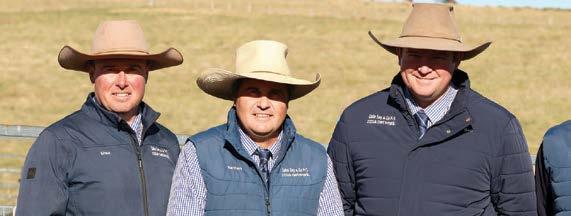
• Amos-Vale Herefords Most Successful Exhibitor Travis Luscombe – 56points
• Jambili Pastoral Co, Dixie at Jandowe took 4 head down 3 steers and 1 heifer.
• The calf that got 2nd of hoof won Class 5A carcass (South Devon x Belgian Blue/ Angus) and the calf that came 4th on hoof came 3rd on hook in the same class (Belgian Blue x South Devon/ Brahman)
• The calf which came 5th on hoof in class 6 A was placed 1st in his carcass and Champion Lightweight Carcass. (Belgian Blue/ Angus x Belgian Blue/ Black Bally)
• They were bred and prepared by James and Kath McUtecheon, James took Callum and Alannah down with him for the competition in Glen Innes.
• Ella Cannon and Travis Luscombe also did very well winning Champions on hoof and hook, Travis was also named most successful exhibitor
• The Limousin State of Origin winners were NSW with 620.4 points and QLD with 603.2 points
• Sponsors Jen-Daview, Benjarra Ascot Cattle co, TCW LIvestock, Amos Vale Herefords
• The early Bird All Breeds Weaner sale will kick of 2026 toward the end of March and the Premier Angus Weaner sale will kick off early Apirl
• Colin Say & Co will host a Show Steer Sale Monday 2nd March and then you can enter the, Beef Extravaganza in September 2026 which will celebrate its ten year and include a very exciting concept of “Battle of the Spectacle“
• Colin Say & Co Working Stock Dog Auction will start a 1pm November 1. at Collette, Glencoe NSW. for more information contact office@colinsay.com.au 02 6732 1266
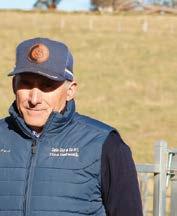



By Alison Desmond, Project Leader BestWool/BestLamb
Drought conditions over winter may have compromised the condition of sheep and reduced their resistance to internal parasites. Short pastures and prolonged grazing close to the ground can increase the risk of worm larvae uptake.
Although pasture growth in spring typically lowers susceptibility, it remains essential to stay vigilant—particularly at and after weaning when young animals are most vulnerable.
Worm infection costs the Australian sheep industry an estimated $436 million per year in lost production. Sheep infected with worms exhibit signs such as weight loss, poor wool growth, scouring, and in severe cases, anaemia or death. The cost of worm infections can be substantial, with losses in growth, wool, and survival, along with treatment expenses.
Weaners are the most vulnerable group of animals, as they have the highest susceptibility to internal parasites. Their natural immunity, which protects them against worms, doesn’t develop until about 12-18 months of age. Stressors associated with the weaning process can also compromise immunity.
Conducting regular Worm egg counts (WECs) provides the best chance of detecting a worm burden and targeting appropriate treatments. A WEC shows the number of worm eggs in a sample of faeces and indicates the size of an internal worm burden.
Regular monitoring through worm tests is crucial. These tests help determine when sheep

exceed the WEC threshold, indicating the need for treatment.
Active monitoring also guides decisions on when not to drench, preventing unnecessary chemical use, saving the cost of treatment and reducing the risk of drench resistance.
The WEC at which you should drench varies based on the worm species and class of stock. Consult your private vet or refer to the Wormboss Drench Decision Guide once you have received your WEC results to decide whether a drench is required.
WEC kits can be provided by your veterinarian or laboratory and will include collection, storage, postage or drop off instructions. For a mob WEC, 20-30 samples of fresh (warm) faeces should be collected.
Some animal health labs can perform a larval culture to identify the type of worms present so you can treat your flock with the most effective drench.
Top tips and tricks for effective drenching
• Test for worms – essential to be regularly conducting with regular WECs. A list of ParaBoss WEC Quality Assured and approved labs is available on wormboss.com.au.
• Use an effective product. The drench should kill 95% or more of the worms, contain at least two active ingredients and be used at the recommended dose rate.
• Calculate the dose rate based on the heaviest animals in the mob. If there is a significant weight range, split the mob. to avoid over or underdosing.
• Move sheep onto a clean paddock immediately after drenching, to maximise the benefits.
• Conduct a second WEC in 10–14 days after drenching, to check that the treatment has been effective.
• Continue to monitor your mobs for increases in WEC and treat as mobs reach thresholds. Careful monitoring can prevent avoidable adverse events and keep your stock thriving. • Know the relative susceptibility of the different classes of livestock on your farm and the types of worms you normally see (a larval culture will determine this).
Worm management is not a set and forget process. It’s vital to be regularly monitoring flock health, WEC levels, and the effectiveness of management strategies. Be prepared to adjust the approach based on seasonal conditions, worm burdens, and sheep performance. Flexibility and responsiveness are key to successful worm control strategies.
Visit Agriculture Victoria Feeding Livestock Website: Worms -monitor, measure and manage for information on WECs, and short videos on the impact of worms and management strategies.
Agriculture Victoria and MLA are co-funding an Enhanced Producer Demonstration Site (EPDS) in East Gippsland demonstrating the application of best practice worm management, including drench resistance testing. For more information visit agriculture.vic.gov.au/on-farmdemos
Find more information about available drought support at www.agriculture.vic.gov.au/ drought or call 136 186.
Australia’s feed grain sector is poised to deepen its engagement with China’s rapidly evolving swine industry, thanks to a strategic initiative led by Grains Australia and the Australian Export Grains Innovation Centre (AEGIC).
The project aims to enhance technical collaboration between the two nations’ stockfeed industries, paving the way for increased utilisation of Australian grains in the world’s largest feed market.
Richard Simonaitis, Chief Executive Officer of Grains Australia, highlighted the longstand-
ing trade relationship between the two countries, noting that Australia has supplied feed grain to China for decades. However, as China’s swine industry expands and becomes more sophisticated, its feed requirements are growing increasingly complex.
“The vision for this project is to develop a shared understanding of the technical constraints and opportunities involved,” Mr Simonaitis said. “Ultimately, we want to see greater uptake of Australian feed grain in China, particularly as it continues to lead global feed production.”
The initiative aligns with Grains Australia’s broader market expansion strategy, supported by its commodity councils. It encompasses a range of grains including barley, wheat, lupins and others, reflecting the diversity of Australia’s feed grain offering.
A recent visit to China saw representatives from Grains Australia and AEGIC engage with key industry associations to explore future cooperation. The discussions were met with enthusiasm, underscoring the mutual interest in capitalising on emerging trade opportunities and fostering stronger technical ties.
As an initiative of the Grains Research and Development Corporation, AEGIC and Grains Australia plan to return to China in the coming months. Their next visit will focus on building trust and technical rapport with major feed mills, further solidifying Australia’s role as a reliable and innovative partner in China’s swine feed supply chain.
This joint effort marks a significant step toward aligning Australia’s grain capabilities with China’s evolving livestock needs an endeavour that promises long-term benefits for both industries.
By Shane Mccarthy, Agforce General President
It was great to welcome the Indonesian Ambassador to Cloncurry for the Recent Beef Up event that continues to go from strength to strength.
Dr Siswo Pramono also spent time touring four local properties the next day to see first hand the beef breeding side of things, which was a first for the Ambassador. He was amazed at the scale, pride and passion which producers displayed.
This came about from the herculean efforts of the AgForce Cattle board - firstly by being part of a delegation to Indonesia earlier this year, and then taking the opportunity to build on those relationships with a trading neighbour so vital to Queensland by then inviting him here.
Because Queensland holds 50% of the National herd we are rightly seen as a vital partner, and going forward these relationships are crucial to ensure the future of live trade.
There’s other big wins to celebrate too. A longheld vision to export bulk grain directly from the Port of Townsville has finally become a reality.
WhatstartedasadreamtobettersupportNorth and Central Queensland growers has led to the first bulk shipment of chickpeas from Townsville to India and Pakistan - a significant milestone for the region’s agricultural and logistics industries.
It’s not overstating to say that this truly marks the beginning of a new era for grain exports from North Queensland, unlocking opportunities that simply weren’t available previously for producers and traders from these regional communities.
The Port of Townsville offers significant advantages for grain transport logistics, as it has the capacity to receive product from inland farms from triple and even quad road trains. While the port doesn’t yet have permanent bulk grain loading infrastructure, there is mobile ship-loading
equipment to enable shipments to proceed smoothly.
Seeing grains and pulses leave Townsville in bulk for the first time brought home to me how this is a win not just for individual producers but for the whole supply chain.
This on top of the latest forecast from the Queensland Primary Industries department of record growth over the past financial year, with new Agtrends figures showing a rise of 18 per cent across the sector from 2023-2024.
After a decade of decline, this is a pivotal turnaround, and brings renewed confidence in the future of Ag.
The increase was across a number of key commodities such as cattle - both at the farm gate and in cattle prices - and also rising demand for chickpeas, poultry and bales.
And it was also a joy to honour 20 remarkable women who made the list of Queensland’s incredible and under-appreciated rural women as part of International Day of Rural Women celebrations.
They are the hidden powerhouses reshaping Queensland’s landscape against the odds, all breaking down barriers and driving innovation. And four are AgForce members! Congratulations to AgForce’s own - current Cloncurry Councillor and Southern Gulf NRN Board Director Jane McMillan, lifelong farmer Skye Titmarsh, fifth generation farmer and chartered accountant Emily Coggan and Toowoomba livestock producer Amanda Burchmann.
The International Day of Rural Women gives us all the chance to acknowledge these often unsung heroes of Queensland - the farmers, producers, Mums, activists and business owners who lead their communities through the incredible highs and lows of rural living.


The Goombungee-Haden AH and P Society held its annual carcase competition in October for vendor-bred cattle only.
Event organisers say the event delivers an exceptional exhibitor experience and education for all vendors as they receive feedback on their animals’ performance.
The Hoof and Hook Competition calendar began on Saturday 5 July, when the cattle arrived at “Hesslands” Maclagan for their Induction process and Initial weigh-in.
All animals met the entry weight specifications of 180kg to 280kg.
The competition saw 23 entries from 23 different producers from the Goombundgee and Hayden districts.
The cattle were fed on a finishing mix for 80 days, at “Hesslands”, Maclagan.
Weighing the cattle for the Best Weight Gain competition began on Saturday, 20 September.
The end of the feed period was on Saturday, Tuesday 23 September at “Hesslands“ and a final weighing and judging of the Hoof competition commenced.
All carcases were AUSMEAT chiller assessed and MSA-graded.
Wednesday, 24 October saw the commencement of the slaughter date at Maclagan Meats and then on Saturday, 27th October vendors viewed the carcases at Maclagan Meats before lunch at Goombundgee Hotel where prizes were awarded. The following prizes were awarded:
• Most Points gained with one beast in carcase and Hoof and Hook was awarded to Scott and Tania Duncombe, Cooyar with an Angus and was sponsored by Wayne and Belinda Hess. Scott and Tania were first time entrants and were blown away by the win and were pleased with the experience and said it’s always good to come away learning from the experience, that is why we entered the competition.
• Second place went to Wayne and Belinda Hess, Waite A Wyle Blonde d’Aquitaines with a heifer
• Hoof Competition was won by Wayne and Belinda Hess, Waite A Whyle Blonde d’Aquitaines with a Blonde x Angus Heifer Hook Competition
• Lightweight Carcase first place went to Scott and Tania Duncombe
• MSA Eating Quality Award went to The Grant Family,
• Best Weight Gain was awarded to Scott and Tania Duncombe
• Largest Eye Muscle area went to M & M Brennan
• Butchers Choice - Wayne and Belinda Hess, Waite A Wyle Blonds
• Highest Dressing Out Percentage - was won by Corey & Tim Schilf, Maclagan Meats with a Blonde/Angus/Speckle Park X.
• Prizes for the Hoof Competition were not awarded to exhibitors whose carcases do not meet the grading criteria.
Carcases that did not meet the below were disqualified and were not eligible for any carcasebased prizes:
• Carcase weight range 180.0kg – 280.0kg
• Carcase P8 fat less than 5mm
• Carcase subcutaneous rib fat less than 3mm
• Carcase ultimate pH greater than 5.70
The committee would like to thank the following sponsors for their generous support - Wayne & Belinda Hess, Ridley Agriproducts, Stephen & Laurel Peters, Lynne & Stephen Hartwif, Errol and Diane Luck, Wait A Wyle Blondes and Wayne and Belida Hess Maclagan Meat sell their product to Allora, Toowoomba, Dalby, Kingaroy and Yarraman.
Wayne and Belinda said they were thrilled with their success, proudly taking out first in Live Carcase, first in Butchers Choice, and second olace Overall an outstanding achievement that reflects the hard work and dedication that goes into their breeding program.
Wayne said it was a great feeling to be recognised among such strong competition and that events like these are more than just about winning ribbons. “It’s always good to go head-tohead with other top producers,” he said. “It’s a fun competition, but more importantly, the feedback we receive is invaluable. It really helps guide our on-farm decisions and ensures we’re heading in the right direction with the cattle we’re breeding.”
He explained that competitions like this give producers the opportunity to assess how their cattle perform against others under the same conditions. The feedback from judges and butchers provides real insight into carcase quality, yield, and market suitability information that’s vital for future breeding decisions.
Wayne and Belinda Hess have also sold 3 Heifers and 1 Steer to Oakey and 1 Heifer and steer to Gympie and said they proud to have commercial cattle headed to Oakey State High School and Gympie State High School for their respective 2026 show teams.

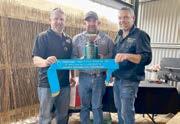


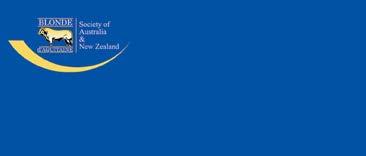



Supporting your business by providing quality products at the

Whether you’re feeding through the dry, finishing cattle for market or improving breeder performance, we’ve got you covered with our extensive range of fully customisable products.
We o er :

•A range of Supplements, Concentrates and Stockfeed with science-backed formulations for cattle, sheep, goats & horses

•We can manufacture and supply custom diets formulated by our qualified nutritionist or your own nutritionist
• Delivery – on time and trouble free
•On farm nutritional consultations & feed testing (conditions apply)
• Protein Meal – Bulk, Bulk Bagged or bagged
• Toll Blending & packaging
• Covered feeders
•Obligation free quotes on blending and packaging your own formulations
















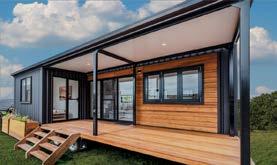


From page 36
Condamine Bell Ladies Results
1. Penny Macintosh on Royal Crown Whiskey178 points.
2. Penny Macintosh on Chickalenas Last - 174 points.
3. Shari Knudsen on Times One Moore - 174 points.
4. Penny Macintosh on Coolum Trinket - 171 points.
5. Kate Southern on Bobadil Condance - 161 points.
6. Shari Knudsen on Yaven Champagne Romance - 161 points.
7. Coralie Daly on Wild Bill - 112 points.
8. Kate Southern on Shesa Blue Badger - 111 points.
9. Lexi Payne on Little Twirl - 111 points.
10. Bryony Puddicombe on Toonga Chrome111 points.
Condamine Bell Novice Results
1. David Duncan on Duncans Kenny - 267 points.
2. Danielle Hogarth on Hazel - 199 points.
3. Cory Pearce on Encore - 178 points.
4. Evan Hiscock on Mandela - 178 points.
5. Pete Comiskey on Time Chex - 178 points.
6. Steve Comiskey on Chics Cadillac - 177 points.
7. Brendan Fitzgerald on Brenwon Ted - 177 points.
8. Bryony Puddicombe on Toonga Chrome177 points.
9. Will Durkin on Hazelwood Cold Power - 177 points.
10. Penny Macintosh on Chikalenas Last - 176 points.

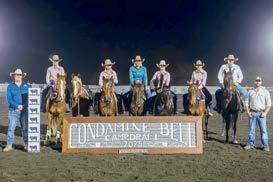


newsdesk@queenslandfarmertoday.com.au
enquiries, contact our
Jane Lowe 0408 488 609
E: jane.lowe@queenslandfarmertoday.com.au
Daniel Pelcl 0408 956 830
E: daniel.pelcl@burnetttoday.com.au
Sharon Jones
P: 07 4182 0451
E: sharon.jones@burnetttoday.com.au
40,000 readership per month
Inserted into the following newspapers:
• South Burnett Today
• Central & North Burnett Today
• Warwick Today
• Stanthorpe Today
• Leader Today
• Jimboomba Today
• Beaudesert Times
• Emerald Today
• CQ Today
• Goondiwindi Argus
Also available from the follow outlets:
• Hartleys Newsexpress Toowoomba
• Roma Sale Yards
• Warwick Sale Yards
• Highfields News & Post
• Pittsworth Newsagency
• News Extra Central City
• Dalby Saleyards
• The Barn, Oakey
• Crows Nest Newsagency
• CQLX Gracemere,
• Longreach saleyards
• Emerald saleyards
• Meringandan Produce
• Goombungee Newsagency

MLA
BEEF
Report Date: 16/10/2025
Saleyard: Blackall
Numbers remained firm at Blackall this week with 2,300 head of cattle penned. Prime cattle continued to dominate the yarding with 200 bulls, 300 bullocks and 800 cows presented. Cows followed a similar trend to other centres, slipping 10-15c, however a better quality run of heavy bulls saw prices increase and southern exporters were stronger on grown steers, pushing prices up 10c/kg. A mixed quality run of light weight restocker steers saw the better quality pens selling to 512.2c to average 488c, while the plainer pens averaged 366c/kg. Feeder steers over 400kg sold to 458.2c to average 439c/kg. Light weight restocker heifers made to 376.2c to average 368c and PTE heifers 330 to 400kg to feed made to 384.2c averaging 356c/kg. A large portion of the cow yarding presented in lighter condition this week with medium weight 3 score cows selling to 360.2c to average 320c while heavy prime cows over 520kg made to 380.2c to average 355c/kg. Heavy grown heifers over 540kg made to 400.2c, bullocks over 600kg sold to 418.2c to average 411c and heavy bulls sold to 432.2c to average 402.2c/ kg. Market reporter, Sam Hart.
Report Date: 22/10/2025
Saleyard: Casino
There was 1,250 head yarded consisting of a good supply of young cattle and a fair penning of cows. The largest percentag of young cattle consisted mainly of weaners in a very mixed quality yarding with increased numbers of light cattle through the sale. The market was easier which was mainly quality related with most weaners selling 10c cheaper and more in places depending on breed. Restocker weaner steers sold from 250c to 455c and the restocker weaner heifers ranged from 240c to 437c/kg. There was several pens of heavy manufacture steers that sold from 370c to 410c/kg. Grown heifers sold to 360c/kg. Light and medium weight cows were 10c dearer, while heavy cows saw little change. The D2 medium weight cows sold from 310c to 338c, while 3 scores ranged from 348c to 360c and 4 score cows sold from 365c to 380c/kg. Heavy bulls reached a top price of 388c/kg. Report by Doug Robson
Report Date: 15/10/2025
Saleyard: Charters Towers
Following the large supply of cattle of recent weeks, a return to a combined prime and store sale saw 3260 head penned. Quality was very mixed comprising of some good pens of heavy bullocks, two very good lines of prime heifers and mixed quality lines of cows and northern bulls. Store cattle were generally many small mixed quality lines and one larger line of young weaned heifers. The regular buyer panel of recent weeks was again active, supported by a regular feeder, one live exporter and opportunity restockers. Cattle were drawn from the northern gulf, Mt Isa to the coast and south to Belyando. Demand was more subdued for animals of lesser quality and weight, resulting in reduced values accordingly. Yearlings to feed rose 2c to 36c, prime yearlings

improved 4c to 31c owing to the improved quality, prime grown steers and heifers increased up to 14c, bullocks eas3 5c and cows were firm to 4c stronger. A good line of young heifers to restockers sold for 364c/kg. Yearling steers above 280kg to backgrounders sold to 376c to average 373c and steers above 330kg to feed averaged 353c, selling to 368c. Heavy steers above 400kg averaged 376c/kg. Medium weight yearling heifers to feed reached 366c to average 351c, prime heifers averaged 320c to 366c/kg. A good supply of heavy yearling heifers to processors topped at 386c to average 367c to 379c/kg. Grown steers above 400kg to live export averaged 337c, steers to the trade averaged 367c/kg. Prime grown steers above 500kg topped at 398c to average 384c/kg. Prime grown heifers sold from 278c to 368c/ kg. Heavy young bullocks to export slaughter topped at 420c, a good sample averaged 408c, full mouthed bullocks sold from 348c to 396c/kg. Medium weight 2 score cows to processors averaged 295c, 3 score cows made to 342c to average 327c/ kg. A reduced supply of prime heavyweight cows sold to 350c to average 328c to 341c/kg. Heavy bulls to processors topped at 342c/kg. Market Reporter, Mick Kingham
Report Date: 17/10/2025
Saleyard: CQLX Gracemere
Due to interruptions from stud cattle sales, CQLX Gracemere sale was held late this week. An offering of 3083 head - 425 head less than the previous sale, was drawn from coastal areas from Bowen south to Bundaberg and west to Theodore. In a very mixed yard of cattle the deteriorating season was evident, with a large percentage of light conditioned cattle on offer. Overall, prices eased, with some of the change due to the standard of cattle present. Light weight pens of yearling steers sold to 509 on occasions, to return averages for the best-bred pens from 451c to 454c/ kg. Plain lines averaged 330c to 360c/kg. Medium weights made to 433c/kg, averaging 400c to 421c/ kg for the best bred pens. Light weight yearling heifers made to 363c/kg for euro cross pens to return averages from 288c to 332c/kg. Medium weight yearling heifers topped at 373c/kg, returning averages from 302c to 332c/kg for well-bred lines. Grown steers and bullocks to processors averaged 405c to 409c/kg for well finished pens. Feeders bought their grown steers to a top of
441c/kg to average 371c to 427c/kg. Grown heifers to the trade sold to top at 389c and average 359c to 372c/kg. Feeders averaged 348c to 392c/ kg for those most suitable. Plain, two score cows averaged from 276c to 280c/kg to processors and restockers, whilst the best, heavy, four score cows averaged 341c/kg and sold to 357c/kg. Heavy bulls sold to processors to average 347c and top at 373c/kg. Cows and calves were mixed in quality and condition, selling from $900 to $1,420 per unit. Reporter: Richard Thomson Report Date: 22/10/2025
Saleyard: Dalby
Interim Report. Cattle numbers at Dalby reduced by 362 head to 5,823. The number of cows penned increased to 1,061 and the supply of bulls reduced to 307 head. The number of cattle from far Western Queensland also reduced to 483 head along with 294 from New South Wales. The remaining 5,046 head were from the local supply areas. Buyer attendance was good and all were active in the market. A relatively small sample of heavy weight yearling steers to feed at the time of this interim report have not maintain the levels of the previous sale. A mixed quality line up of medium weight yearling heifers to feed sold to a cheaper trend. However an excellent lineup of heavy weight yearling heifers to feed improved in price. Heavy grown steers and bullocks averaged 5c/kg better. Cows averaged a few cents cheaper against the reduced prices of the previous sale. Heavy weight yearling steers under 480kg to feed made to 482c to average 460c and some over 480kg also made to 482c/kg. Medium weight yearling heifers to feed made to 428c to average 372c and heavy weights to feed made to 450c to average 434c/kg. Bullocks made to 424c to average 422c/kg. Heavy grown heifers made to 418c to average 412c/kg. Medium weight 2 score cows averaged 330 and made to 341c/kg. Heavy weight 3 score cows averaged 357c and the best of the cows made to 385c to average 373c/kg. Heavy weight bulls made to 400c/kg. Market Reporter. Trevor Hess.
Report Date: 21/10/2025
Saleyard: Roma
Roma Agents yarded 5,923 head very similar numbers to last sale. The regular buyers attended and operating. The quality of the yarding was mixed which included more lighter conditioned cattle on offer. The market firm to slightly cheaper for most categories. Yearling steers 200 to 280kg topped 540c to average 511c/kg. Yearling steers 280 to 330kg sold from 424c to 540c/kg to restockers. Yearling steers 330 to 400kg made from 358c to 504c/kg also to restockers. Yearling steers 400 to 480kg selling to 480c Lot Feeders and 490c/kg to restockers. Yearling steers over 480kg to 460c/ kg to restockers. Yearling heifers 200 to 280kg with the restockers selling from 284c to 440c/kg for the better pens. Yearling heifers 280 to 330kg categories improved on last sale and sold from 300c to 438c/kg to restockers. Yearling heifers 330 to 400kg topped 410c to restockers and 410c/kg to Lot Feeders. Yearling heifers 400 to 480kg sold to 402c/kg. Grown steers 400 to 500kg made to 486c/kg Lot feeders. Grown steers 500 to 600kg made to 410c/kg. Bullocks over 600kg to 432c/kg
to processors similar to the previous sale. Grown heifers over 540kg to 362c/kg. The cow offering was not up the previous sales quality which reflected in the market. The best of the 3 score cows to 390c/kg. The 2 score cows sold from 226c to 346c/kg. Bulls up to 450kg sold to 460c/kg. Bulls 450 to 600kg made to 374c/kg. Bulls over 600kg made to 420c/kg. Market Reporter David Friend. Report Date: 21/10/2025
Saleyard: Warwick
The supply of stock at Warwick remained stable with agents penning 1,115 head of improved quality yearling steers and heifers along with well finished trade weight yearlings plus grown steers and cows to processors. All the regular buyers attended and operated. Yearling steers to restockers and feed sold to dearer trends with the heifers remaining close to last week. Bullocks eased in price however plain cows sold to dearer trends with good heavy cows similar to last sale. Yearling steers in the 200-280kg range to restockers made 510c to average 460c/kg. Yearling steers over 280kg to feed sold to 480c/kg. Medium and heavy weight yearling steers to feed sold to 476c and averaged from 441c to 444c/kg. Yearling heifers in the 200-280kg range to background made 412c to average 391c/kg. Medium weight yearling heifers to feed sold to 416c with those to the wholesale meat trade at 436c/kg. Heavy yearling heifers to the wholesale meat trade made 440c to average 390c/kg. Bullocks to processors sold to 440c and averaged 423c/kg. Grown heifers to processors made 429c to average 401c/kg. Light weight plain conditioned to processors made 345c to average 315c/kg. Score 2 heavy cows made 345c to average 332c/kg. Good heavy cows topped at 396c to average 373c/kg. Light weight bulls to restockers sold to 378c/kg. Heavy bulls to processors sold to 420c and averaged 382c/kg. Market Reporter Errol Luck.
SHEEP Report Date: 15/10/2025
Saleyard: Warwick
Numbers reduced to 766 lambs and 514 mutton at Warwick. With the reduction in supply not all processors attended which resulted in prices for trade weight lambs easing from $9 to $14/ head and the mutton lines easing from $12 to $37/head. Light weight young lambs to restockers sold from $80 to $100/head. Young lambs over 12kg to restockers sold from $76 to $122/head with butchers paying to $135/head. Young lambs in the 16-22kg range to butchers sold from $140 to $239/head. Older light weight lambs to restockers and to feed sold from $92 to $114/head. Lambs in the 18-20kg range to the butcher trade sold from $120 to $206/head. Lambs suited to the wholesale meat trade sold from $200 to $272 with the best heavy lambs topping at $283/head. Hoggets to processors sold from $195 to $230/head. Merino ewes to processors sold from $138 to $182 with restockers paying to $202/head. Dorper and crossbred ewes to processors sold from $145 to $221/head. Wethers to processors sold from $151 to $221/head. Ram lambs to the wholesale meat trade sold from $164 to $212/head. Rams to processors sold from $144 to $217/head. Market Reporter Errol Luck.


By Fiona Gowers
In a compelling display of precision and consistency, NSW horseman Hugh Miles has again asserted his dominance in the campdraft arena, winning the Condamine Bell Open Campdraft in 2025.
In front of 900 spectators - both onsite and online - he rode Smart n Spicy to victory for owners Peter and Carolyne Doonan, Charters Towers, combining scores of 89, 92 and 88 in the final for an aggregate of 269 points to clinch the $75,000 winner’s cheque.
Mr Miles previously won “The Bell“ in 2023 and the Slotted Shoot Out in 2024.
“It’s a great accomplishment to win such a prestigious campdraft especially on a mare for some very good clients who I’ve been very fortunate to have for a long time,“ Mr Miles said.
“To win on their mare and have the other three



place in the top 10 is pretty special for all of us.“
Now a seven-year-old mare, the Doonans bought Smart n Spicy as a yearling from breeder Jodie Mearns.
She is sired by Dual Smart Rey and out of Scary Spice.
In April, Mr Miles and Smart n Spicy won $28,000 at the Koobah Performance Horse featured maiden, bringing the mare’s earning to more than $100,000 from three campdrafts this year.
“Smart n Spicy has always been super trainable and soft,“ Mr Miles said. “I have always liked her from the start. She’s super intelligent and just always willing to please.“
Mr Miles, who trains horses and operates a small feedlot to the east of Dungowan/ Woolomin on the Peel River in NSW, has competed in campdrafts for “20 odd years“.
“I started when I was probably around 14 or


15. I enjoy catching up with mates that I don’t get to see regularly as these days I spend most of my year attending all the major cutting aged events.“
Meanwhile, Penny Macintosh won the Joyce Campbell Memorial Ladies, riding Royal Crown Whiskey for owners Les and Carmen Stewart. She secured three of the top four places.
Royal Crown Whiskey is an eight-year-old mare sired by One Time Royalty and out of OK Brandy n Wine.
Teys Australia livestock manager David Duncan, Condamine won the Teys Australia Novice on his home-bred gelding Duncans Kenny, a nine-year-old gelding sired by Brown Victory and out of Duncans Emmi.
Judges at the Condamine Bell Open Campdraft in 2025 included, Brian Elliott (open and ladies), Tim Hollis (open), Cameron Wilson (novice) and Robert Daly (Slotted Shoot Out).
The Grove, Lillyvale Feedlot, Condabri Feed-
lot and Justin and Kate Boshammer donated the cattle.
Condamine Bell Open Results
1. Hugh Miles on Smart n Spicy - 269 points.
2. Matthew Moffat on Durkins Stylish Quincy268.5 points.
3. Robert Plant on Kooldet - 267.5 points.
4. Hugh Miles on Summa Reyn - 267 points.
5. David Reiter on Cody - 266.5 points.
6. Will Durkin on Barefoot VIP - 266.5 points.
7. Hugh Miles on Moore Spoonful - 266.5 points.
8. Hugh Miles on Tuff n Dainty - 266.5 points.
9. Sam Greenup on Kanandahpark Shakira265.5 points.
10. Penny Macintosh on Royal Crown Whiskey264.5.
Continued page 34
